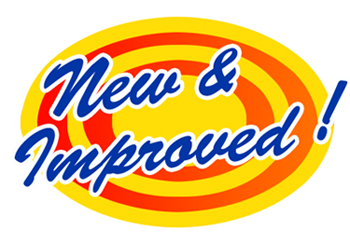
Day to Day #psychedelicmirrors Calendar!
It occurred to me
that having days, side by side might prove confusing
or annoying or both, so from here on out, your
calendar will be a tad easier to read. Yes, there
still will be scrolling to do, but I know you are up
to the challenge!
|
TUESDAY SEPTEMBER 13, 2016
We wake up bright and early Tuesday morning rested and
content. In our hands? Our bright red and newly read
copy of Richard Appignanesi and Oscar Zarate's new book
HYSTERIA part of the Graphic Freud series. That's right!
You've read the complete book, the whole enchilada, BEFORE
walking into our den of psychedelic dreams. NOTE: if you
have just joined/added our class it is ESSENTIAL that you
have the assignment FINISHED before, yes BEFORE, you walk
into the room for class at 11am.
GRAPHIC FREUD: HYSTERIA is a collaborative effort!
As important as it is to read Richard Appignanesi's
compelling overview of Viennese shrink Sigmund
Freud's groundbreaking ruminations on the nature of
Hysteria, it is just as crucial to do close
readings/examinations of Zarate's haunting
illustrations. 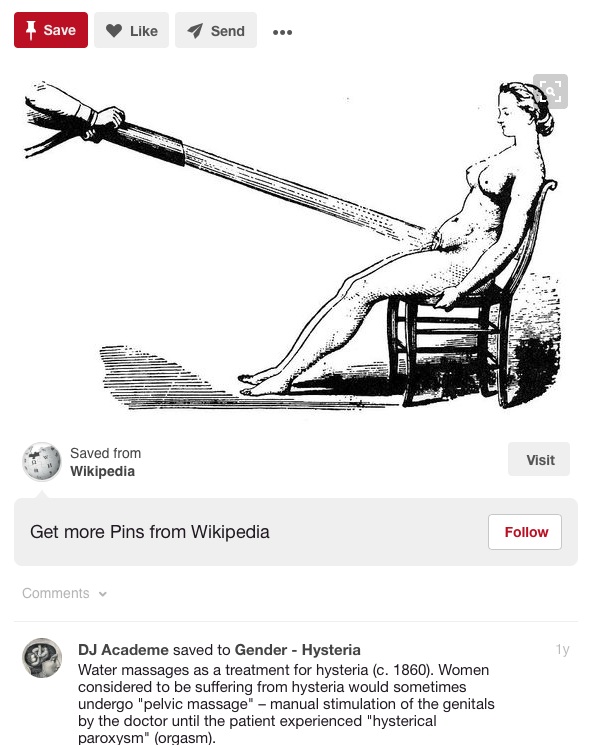 Note that the cover, while
bracing, actually does Freud a disservice as his greatest
breakthrough with regard to hysteria was that both women and men could suffer
from this condition--old
ideas die hard! Though you are only
required to read it for Thursday, it may prove diverting
to read Charlotte Perkins Gilman's THE YELLOW WALLPAPER
halfway through your reading of HYSTERIA, so that the
pages/ideas of both books can flow together in your crazy
little head! Note that the cover, while
bracing, actually does Freud a disservice as his greatest
breakthrough with regard to hysteria was that both women and men could suffer
from this condition--old
ideas die hard! Though you are only
required to read it for Thursday, it may prove diverting
to read Charlotte Perkins Gilman's THE YELLOW WALLPAPER
halfway through your reading of HYSTERIA, so that the
pages/ideas of both books can flow together in your crazy
little head!
For the truly enlightened and interested--gloss Richard T.
Gray's lecture notes on Freud and Hysteria, here,
then sample Sander Gilman on images of hysteria here.
Still not satiated? Get a taste of Sigmund Freud's writing
here.
|
|
THURSDAY
SEPTEMBER 15
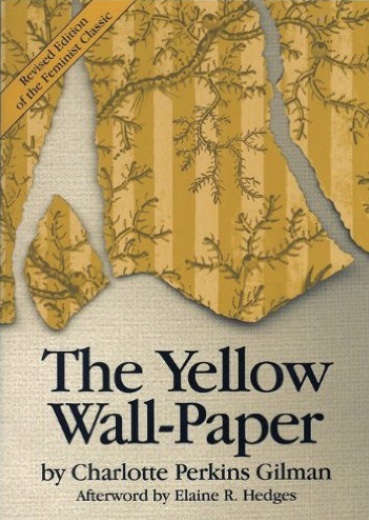 Finally! Finally--the
silent literati in the room rejoice as we now, for the
first time plunge into some proper, real, bona fide,
LITERATURE--the short story masterpiece, "The Yellow
Wall-Paper" by Charlotte Perkins Gilman. The story
is short! Super-short. So the first time you read
the story, just sit down and read it straight through
without any stops. Finally! Finally--the
silent literati in the room rejoice as we now, for the
first time plunge into some proper, real, bona fide,
LITERATURE--the short story masterpiece, "The Yellow
Wall-Paper" by Charlotte Perkins Gilman. The story
is short! Super-short. So the first time you read
the story, just sit down and read it straight through
without any stops.
Next?
Put the book away for a day.
The next day (and, of course all this is happening BEFORE
class, today, Thursday, September 15, 2016), 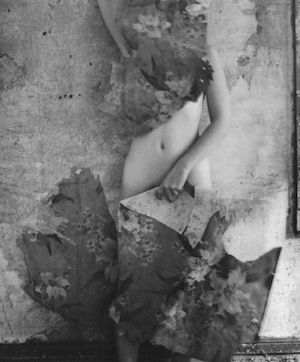 I want you to carefully read and
survey the images by & featuring Francesca Woodman
that appear here
in a New York Review of
Books piece by Elizabeth Gumport. Rachel Cooke's
piece in the Guardian
is also moving, so
give it a read if you can. Ariana Reines's piece is
awesome--but
I know, too much for you, right? I want you to carefully read and
survey the images by & featuring Francesca Woodman
that appear here
in a New York Review of
Books piece by Elizabeth Gumport. Rachel Cooke's
piece in the Guardian
is also moving, so
give it a read if you can. Ariana Reines's piece is
awesome--but
I know, too much for you, right?
Also, take the time to carefully surveil the photographs
by Woodman archived on this page--is
there
any particular one or two that evoke the feelings you
experienced reading Gilman's short story!? If so,
print one out that particularly touched you and bring it
to class to share during our final segment of the class:
"YOU'RE THE PROFESSOR."
Last thing to do? Read
a little about Gilman--she was something else and
way ahead of her time.
|
|
TUESDAY SEPTEMBER 20
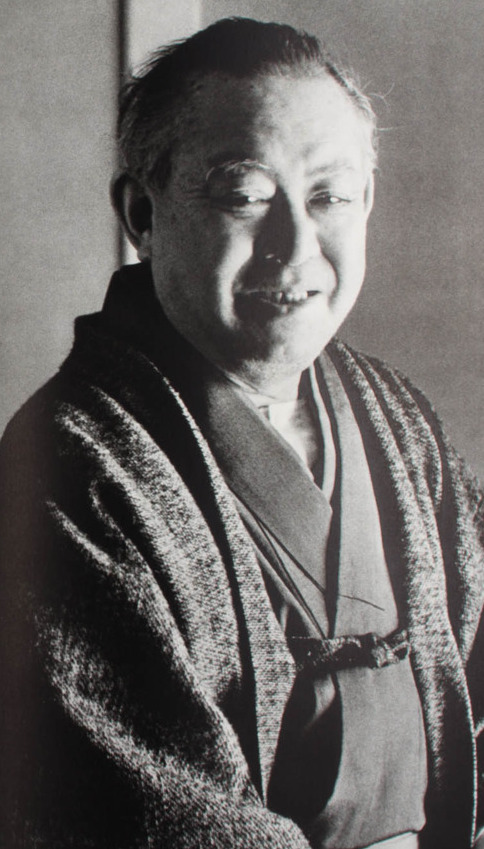 This fine Tuesday is pretty
amazing. You walk into our den of psychedelic inquiry
having read up to the April 17nth chapter of Junichiro
Tanizaki's THE KEY. Unless you want to finish it as
most of you likely will do. This fine Tuesday is pretty
amazing. You walk into our den of psychedelic inquiry
having read up to the April 17nth chapter of Junichiro
Tanizaki's THE KEY. Unless you want to finish it as
most of you likely will do.  At first glance, the genre into
which we place this striking piece of storytelling alludes
us: is it a diary? two diaries? a memoir? twin memoirs? a
piece of epistolary fiction? Probing closer, we
realize it is a novel--our first bona fide novel
this semester. At first glance, the genre into
which we place this striking piece of storytelling alludes
us: is it a diary? two diaries? a memoir? twin memoirs? a
piece of epistolary fiction? Probing closer, we
realize it is a novel--our first bona fide novel
this semester.
And it is a good one! Dare I say, a great one. Tanizaki's
ability to make the hidden mind, imagination, of two
characters trapped in a relationship from hell will leave
you demanding more and more (while it is NOT a requirement
for this course, you are welcome to read DIARY OF A MAD
OLD MAN, also included with the edition of the book I had
ordered for you at the bookstore, the Vintage
International edition.
|
|
THURSDAY
SEPTEMBER 22
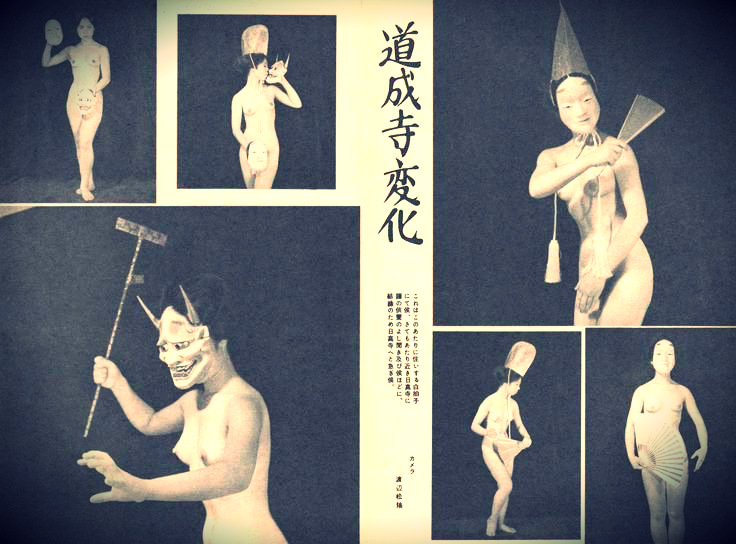
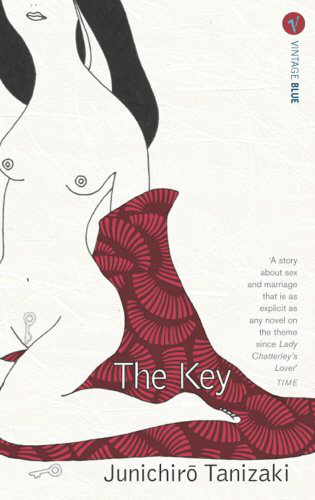  Junichiro Tanizaki's
THE KEY is now in your rear-view window as you enter the
airy confines of GMCS 333. In preparation for today's
class, you have very little reading--the novel ends on
page 157 of the edition we ordered for your psychedelic
seminar. Instead, use the extra time you have when you
finish the book to go back and reread the first 20 or so
pages of the novel after
you learn how it ends. Look for the little clues,
tips, games, ciphers and more that Junichiro Tanizaki uses
to build his wicked little machine of a novel. Certainly
one of the things he wants to do is explore the depth and
complexity of human desire--that is on the surface.
Additionally, examining the dimensions of human duplicity
are also at the fore. But what if there is a bigger
trick--a bigger game? Could it be that the deluded older
man in THE KEY, the object of Ikuko's subterfuge, is not
the only victim? That you, indeed, the reader, may be the
other victim played the fool? Bring to class a paper
onto which you have typed out a brief passage from the first
50 pages or so of the novel that you have
determined to be essential, dynamic, meaningful, or
provocative! This should also be a selection that speaks
to, or is in interaction with, a brief passage (two or
three sentences is fine) from the last
50 pages of the novel. That's it--but be prepared to
justify your selection of these two passages in a
paragraph-length argument when called upon to do
so in class. Junichiro Tanizaki's
THE KEY is now in your rear-view window as you enter the
airy confines of GMCS 333. In preparation for today's
class, you have very little reading--the novel ends on
page 157 of the edition we ordered for your psychedelic
seminar. Instead, use the extra time you have when you
finish the book to go back and reread the first 20 or so
pages of the novel after
you learn how it ends. Look for the little clues,
tips, games, ciphers and more that Junichiro Tanizaki uses
to build his wicked little machine of a novel. Certainly
one of the things he wants to do is explore the depth and
complexity of human desire--that is on the surface.
Additionally, examining the dimensions of human duplicity
are also at the fore. But what if there is a bigger
trick--a bigger game? Could it be that the deluded older
man in THE KEY, the object of Ikuko's subterfuge, is not
the only victim? That you, indeed, the reader, may be the
other victim played the fool? Bring to class a paper
onto which you have typed out a brief passage from the first
50 pages or so of the novel that you have
determined to be essential, dynamic, meaningful, or
provocative! This should also be a selection that speaks
to, or is in interaction with, a brief passage (two or
three sentences is fine) from the last
50 pages of the novel. That's it--but be prepared to
justify your selection of these two passages in a
paragraph-length argument when called upon to do
so in class.
NOTE: Today you will receive your first paper
assignment--
Analytical Imagination Challenge Numero Uno!!!!
It
will be due Tuesday, October 11, 2016, at the
beginning of class . Be sure to put it in the
correct bag for your team--they will be clearly marked.
Note there will be five bags as you have the choice to
be graded by your wonderfully gifted and kind TA or your
unpredictable, demanding, picky Professor

KATLIN SWEENEY
Trippy Dreamers
Ackerman to
Fergus |

CASEY HANDS
Groovy Hallucinators
Fitch to Macedo |

LAUREN LUEDKE
Psychedelic Surfers
Mackenzie to
Roscelli |

JENN CARTER
Phantasy Foragers
Roueenfar to
Zralka |

BILL
NERICCIO
Cruel
Demanding
Academic
Type
|
|
|
Link to your first Imagination Challege (aka,
your 1st essay)
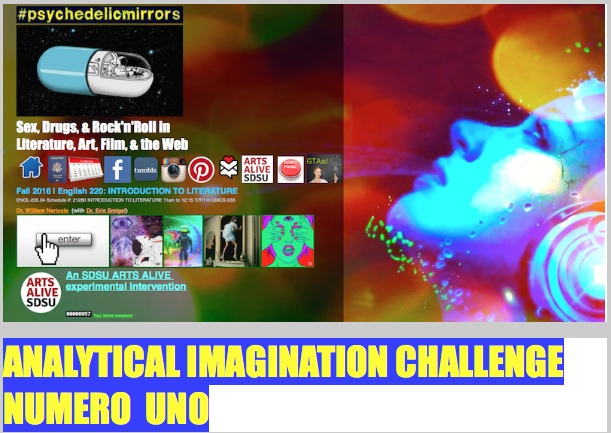
|
TUESDAY
SEPTEMBER 27
CLASS in GMCS 333
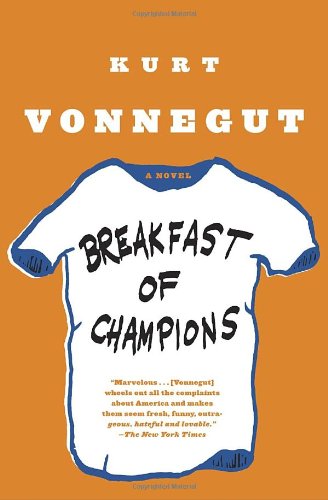
What a weekend--you walk into our psychedelic teatro, GMCS
333, having read up to page 180 in Kurt
Vonnegut's BREAKFAST OF CHAMPIONS. You pat yourself
on the back for your achievement (the largest dosage of
reading we will have this semester, probably). In
these first 16 chapters you are introduced to one of the
more gifted American novelists of the  20th century--and
certainly one of the more singular voices in the history
of literature. Know that Vonnegut's background was
NOT literary--he was a below average biochemistry
undergraduate at Cornell University (go Big Red!) and
later, a University of Chicago cultural anthropology
dropout. After surviving the Dresden firebombing in WWII,
he returned to the U.S. and worked as a spokesman for
General Electric. The time he spent in the bowels of
CORPORATE AMERICA did a number on his head (his psyche
too) and he spent the rest of his long, prolific life
sorting things out. 20th century--and
certainly one of the more singular voices in the history
of literature. Know that Vonnegut's background was
NOT literary--he was a below average biochemistry
undergraduate at Cornell University (go Big Red!) and
later, a University of Chicago cultural anthropology
dropout. After surviving the Dresden firebombing in WWII,
he returned to the U.S. and worked as a spokesman for
General Electric. The time he spent in the bowels of
CORPORATE AMERICA did a number on his head (his psyche
too) and he spent the rest of his long, prolific life
sorting things out.
 ALSO!
For
the second time this semester, we are synchronizing our
psyches with the 200 students in Professor Eric Smigel's
class--so do take the time to peruse the links to that
material! ALSO!
For
the second time this semester, we are synchronizing our
psyches with the 200 students in Professor Eric Smigel's
class--so do take the time to peruse the links to that
material!
Psychedelic Surf Rock in Los Angeles
Listening: The Electric Prunes, “I
Had Too Much to Dream (Last Night)” (1966) + The
Beach Boys, “Good
Vibrations” (1966)
Reading: Jules Siegel, “Goodbye Surfing Hello God!—The
Religious Conversion of Brian Wilson” (1967) + Notes on
"I Had too Much to Dream (Last Night) & "Good
Vibrations
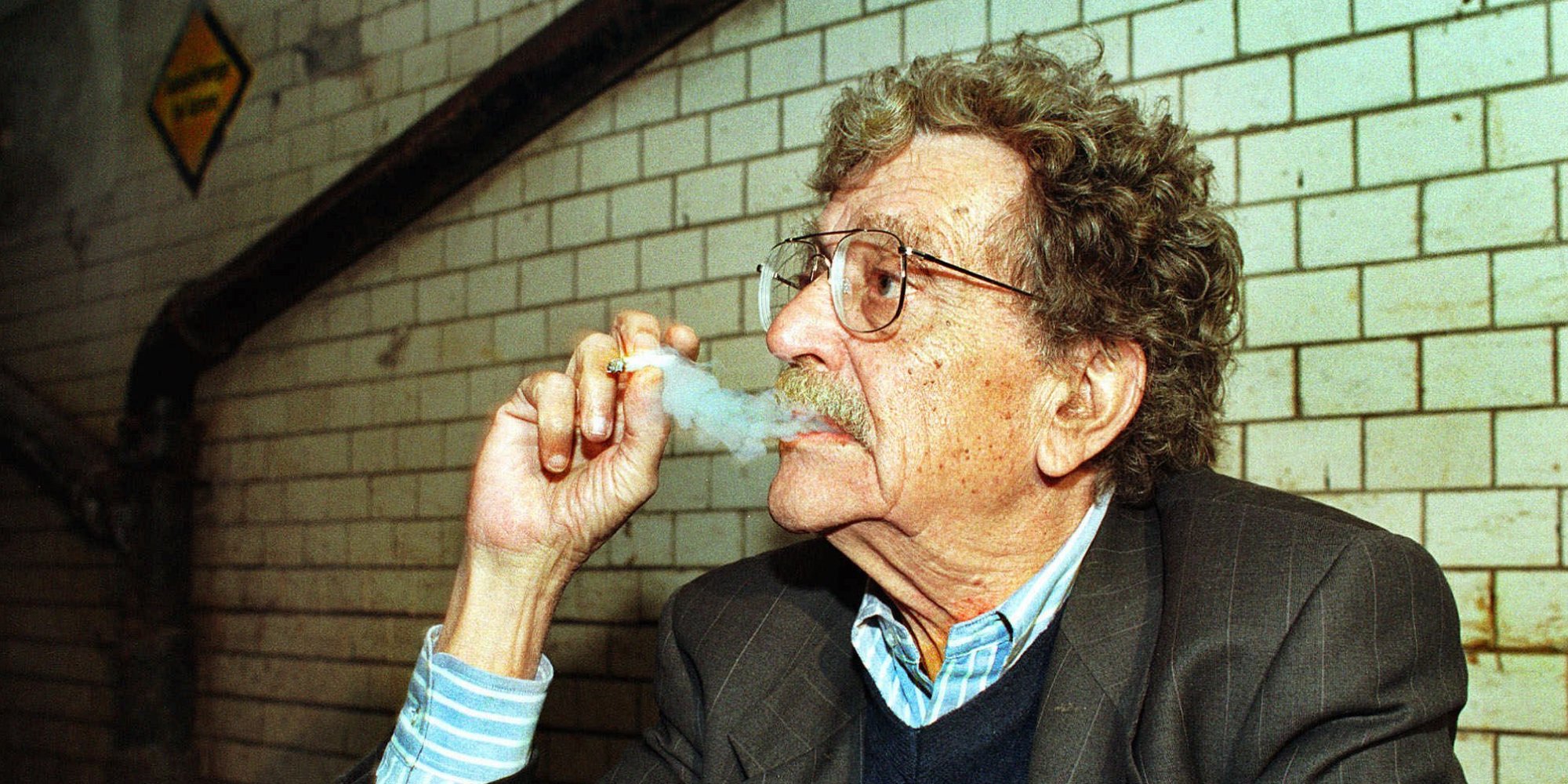
|
|
THURSDAY
SEPTEMBER 29
CLASS IN THE DON POWELL
THEATER

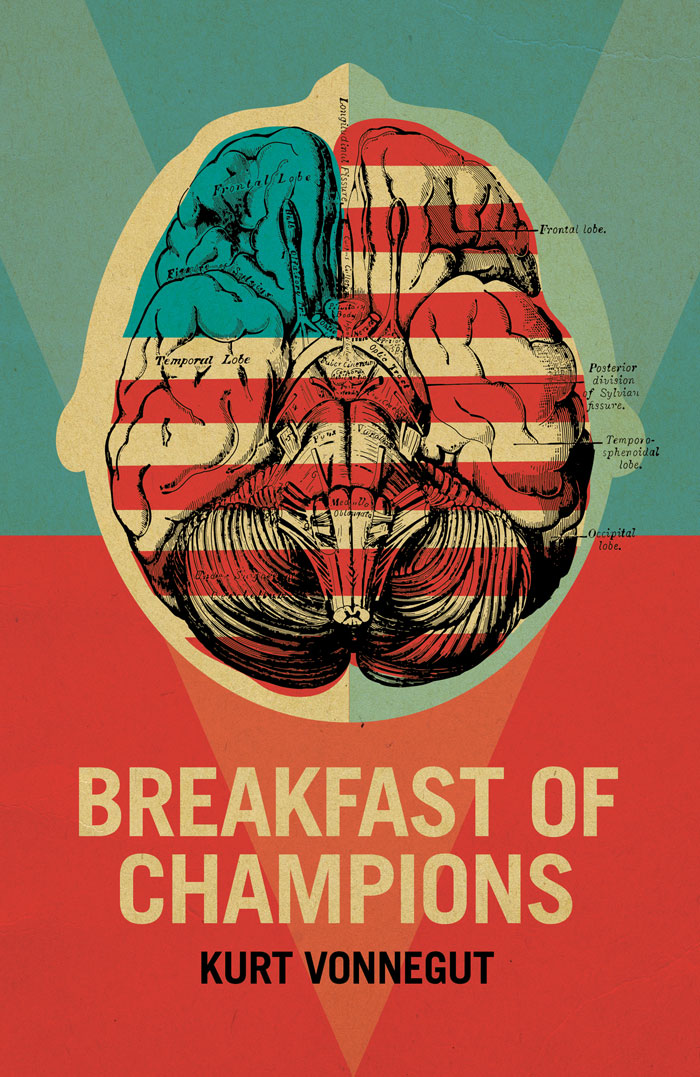 NOTE!
CLASS WILL MEET IN THE DON POWELL THEATRE NOTE!
CLASS WILL MEET IN THE DON POWELL THEATRE
THE PSYCHEDELIC SCENE IN LA & KURT VONNEGUT'S
BREAKFAST OF CHAMPIONS are both on the plate for our
second joint class with the groovy music-heads in Eric
Smigel's MUSIC 351 class. For today you have finished
reading BREAKFAST OF CHAMPIONS and are ready to get into a
discussion of what ties together Vonnegut's scathing
critique of mainstream American corporate culture and the
visionary rantings/music of the ultimate American rock and
roll band, the Doors (Lead singer and 60s "bae" Jim
Morrison, pictured above). When you finish your
reading do your work that we share with our music-head
friends:
When You’re Strange: The Doors
Listening: The Doors, “Break
On Through” (1967); + The Doors, “People
Are Strange” (1967)
Reading: Jerry Hopkins, “The Rolling Stone Interview:
Jim Morrison” (1969) + Notes on "People are Strange" and
"Break on Through
|
|
TUESDAY
OCTOBER 4
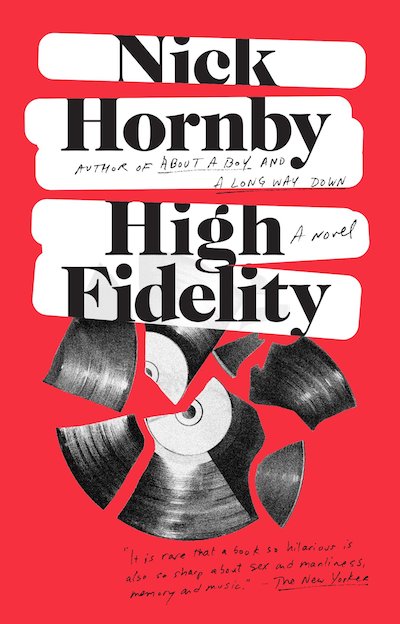 Music and the
Psyche--Nick Hornby's HIGH FIDELITY Music and the
Psyche--Nick Hornby's HIGH FIDELITY
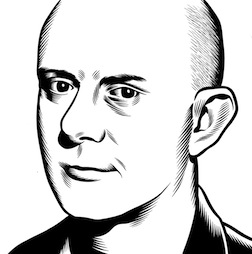
Read to page 134 in Nick Hornby's outstanding novel. Where
in "The Yellow Wallpaper" we walked around inside the head
of a woman battling all kinds of neuroses, we now get to
spend three days inside the head of Rob, an equally mixed
up person, only this time, a man. The psyches of men
and women and others are our domain this term. Consider
how Hornby deepens your understanding of human psychology
and the male psyche.
|
|
THURSDAY
OCTOBER 6
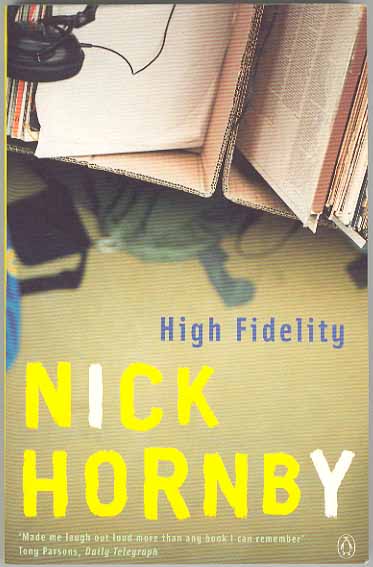 Try as hard as you can to finish
reading Nick Hornby's HIGH FIDELITY!!!!!! Try as hard as you can to finish
reading Nick Hornby's HIGH FIDELITY!!!!!!
Hornby probes various aspects of the male psyche whilst
linking it--in his main protagonist Rob Fleming--to the
trajectory of the rock music industry and music in
general.
As you read, consider the relationship between psychology
and music. In our YOU'RE THE PROFESSOR segment for
today, be prepared to cue up and play part of a song that
triggers episodes of nostalgia for you and to share it
with the class.
The first 7 people to email me at memo@sdsu.edu with the
link to song on YouTube will have the chance to play a bit
of music and share past histories in front of the class
today.
|
|
TUESDAY
OCTOBER 11
No reading! Why? You know why:
Analytical Imagination Challenge Numero Uno Due
Today at the Beginning of Class!
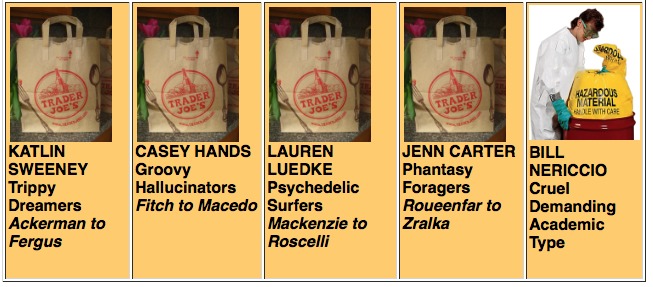

In class we will screen:MAD MEN!

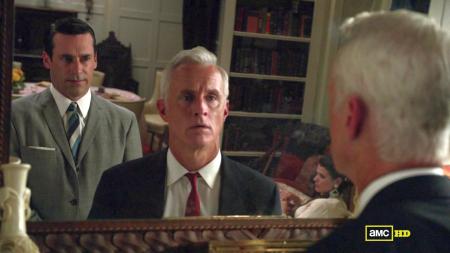 Directed
by Scott Hornbacher with a screenplay by Semi Chellas and
series creator Matthew Weiner, the "Far Away Places,"
Season 5, Episode 6 (2012) chapter of AMC's Mad Men is memorable
for multiple reasons: structure, writing, acting, and
cinematography. It is also one of the more
'literary' episodes blending three parallel narratives
with a secret hanging over it throughout: a lurking
knowledge that somehow these three narratives are
thematically fused. After we watch the episode in class
today, make
a visit to this site and marvel at all the details
that go into creating a period piece for contemporary
television. Directed
by Scott Hornbacher with a screenplay by Semi Chellas and
series creator Matthew Weiner, the "Far Away Places,"
Season 5, Episode 6 (2012) chapter of AMC's Mad Men is memorable
for multiple reasons: structure, writing, acting, and
cinematography. It is also one of the more
'literary' episodes blending three parallel narratives
with a secret hanging over it throughout: a lurking
knowledge that somehow these three narratives are
thematically fused. After we watch the episode in class
today, make
a visit to this site and marvel at all the details
that go into creating a period piece for contemporary
television.

|
|
THURSDAY
OCTOBER 13
 For class today, read the Introduction to
Tex[t]-Mex entitled "Backstory,"
pages
15 to 30, and the first 15 pages or so of the chapter on
Orson Welles's TOUCH OF EVIL. In class we will begin
to screen Welles's drug-filled tale of fun and treachery
along the U.S. / Mexico border. Welles's border
epic/film noir classic asks that we reconsider the
contours of the cultural space we live in--this will be
hard work. As we have learned in the last year (and
especially from the presidential race!!!), hallucinations
of the "Mexican" in American (and California) fuel
nightmare scenarios for "Mexicans" and "Americans" alike.
Welles seeks to make this nightmare more complicated (as
do I with my own gnarly prose takes on the same). Read
slowly and carefully, and don't be shy about having a
dictionary (or dictionary app) nearby as you plod through
the swamps of my imagination. For class today, read the Introduction to
Tex[t]-Mex entitled "Backstory,"
pages
15 to 30, and the first 15 pages or so of the chapter on
Orson Welles's TOUCH OF EVIL. In class we will begin
to screen Welles's drug-filled tale of fun and treachery
along the U.S. / Mexico border. Welles's border
epic/film noir classic asks that we reconsider the
contours of the cultural space we live in--this will be
hard work. As we have learned in the last year (and
especially from the presidential race!!!), hallucinations
of the "Mexican" in American (and California) fuel
nightmare scenarios for "Mexicans" and "Americans" alike.
Welles seeks to make this nightmare more complicated (as
do I with my own gnarly prose takes on the same). Read
slowly and carefully, and don't be shy about having a
dictionary (or dictionary app) nearby as you plod through
the swamps of my imagination.
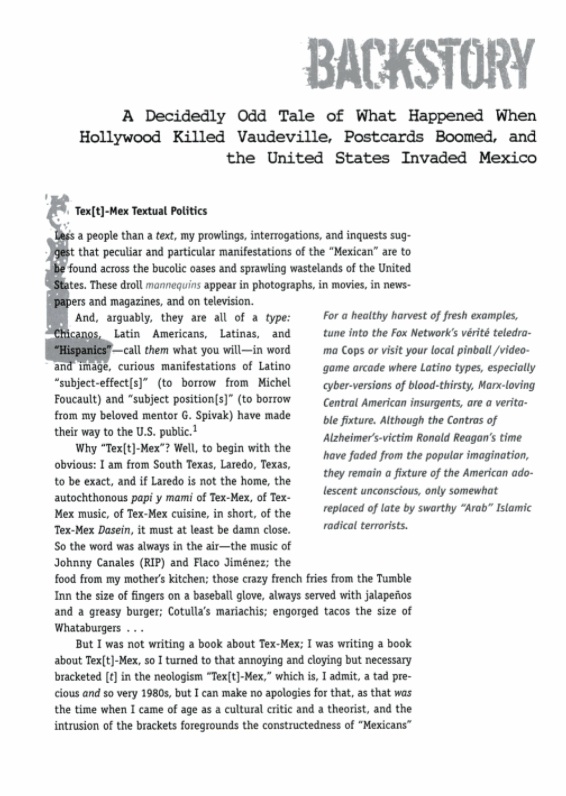
|
|
TUESDAY
OCTOBER 18
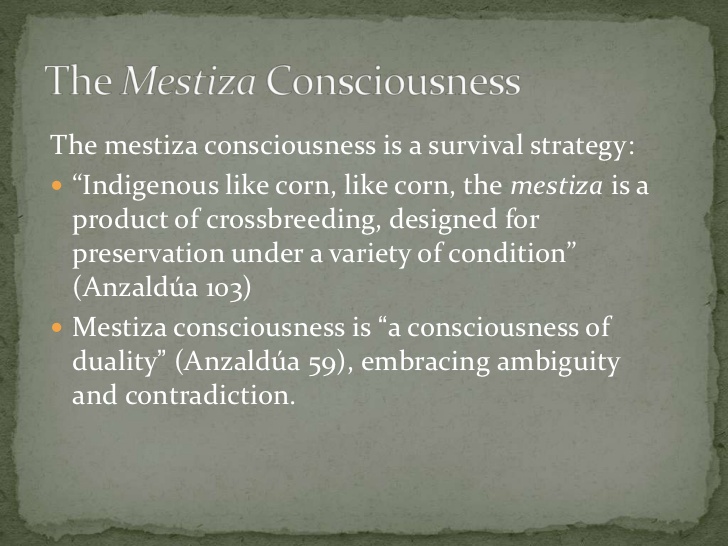
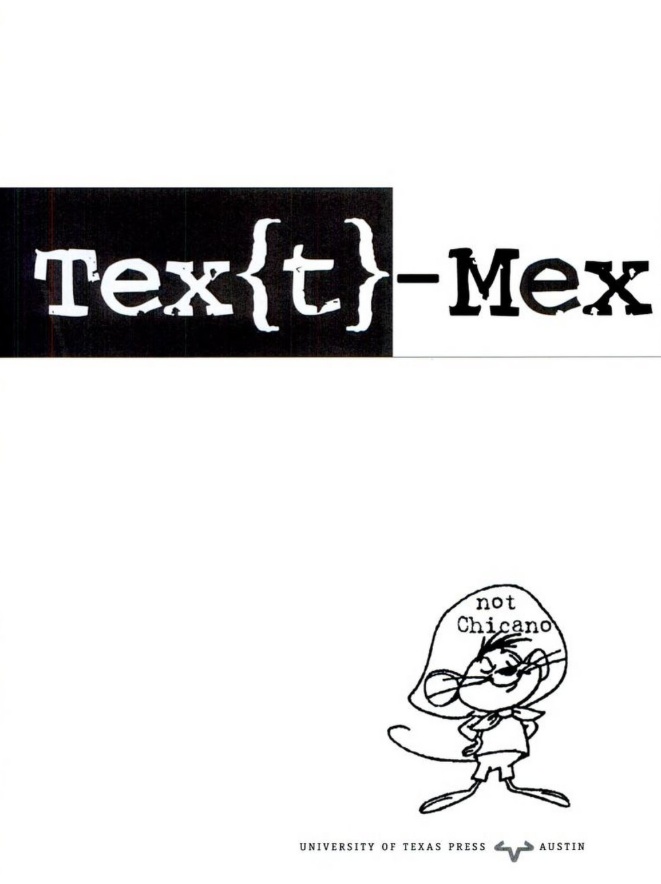 Our
screening of Touch of
Evil continues in class today--enter the
room having finished the chapter on Welles's film TOUCH OF
EVIL and having read both the chapters on Rita Hayworth
and Speedy Gonzalez. Welles's tale of Sex, Drugs, and
Rockn'Roll set along the US/Mexico Border opens our eyes
to what may be thought of as a "psychology of the border."
Are there particular phenomena associated with being
Mexican in America? With being bilingual. With being part
of a population that needs to be "walled in."? Our
screening of Touch of
Evil continues in class today--enter the
room having finished the chapter on Welles's film TOUCH OF
EVIL and having read both the chapters on Rita Hayworth
and Speedy Gonzalez. Welles's tale of Sex, Drugs, and
Rockn'Roll set along the US/Mexico Border opens our eyes
to what may be thought of as a "psychology of the border."
Are there particular phenomena associated with being
Mexican in America? With being bilingual. With being part
of a population that needs to be "walled in."?
|
|
THURSDAY
OCTOBER 20
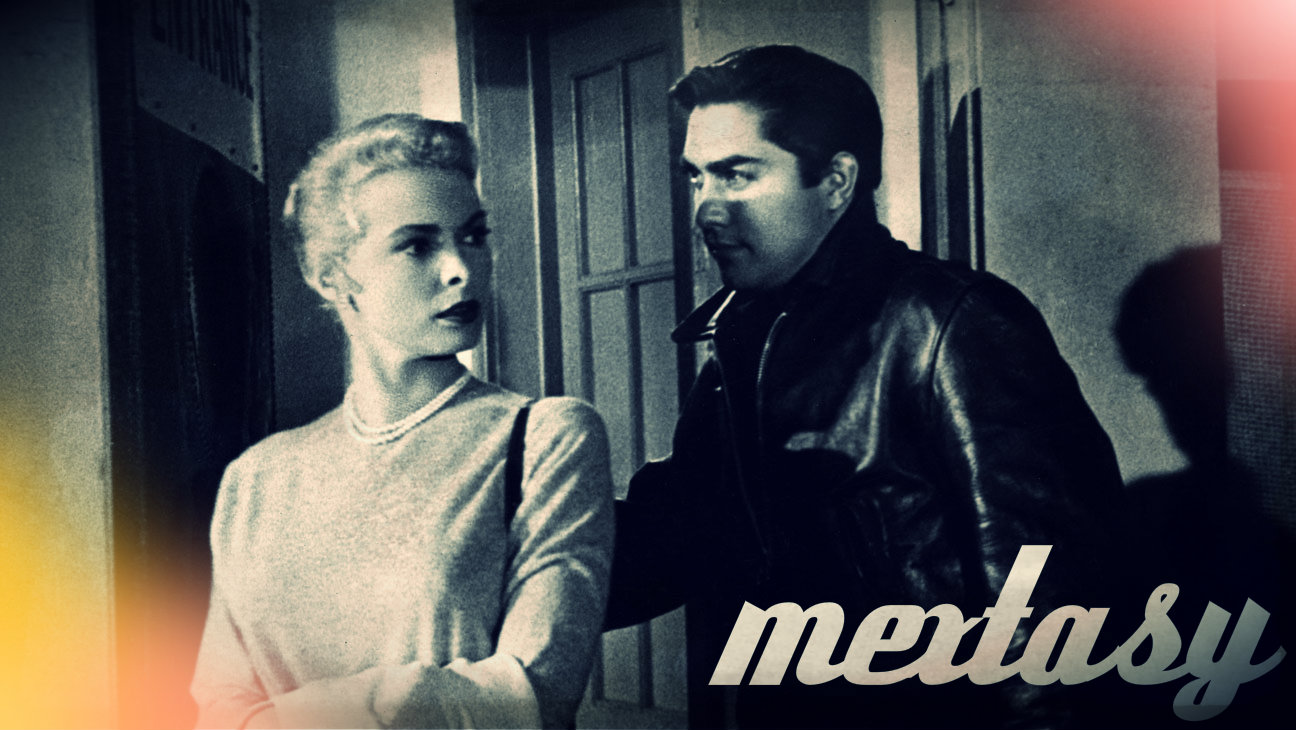
Read the two "Seductive Hallucination Galleries" sections
of TEXTMEX pages 31-38 & 173-190; also, begin to read
Carlos Fuentes's THE CRYSTAL FRONTIER, perhaps just the
first chapter, though we may not have time to deal with
all of the readings during our seminar. To top things off
we will begin class by concluding our screening of
Welles's nightmare classic TOUCH OF EVIL and continue our
discussion of the psychedelic/psychotropic warping of
consciousness that takes place along the U.S. / Mexico
border.
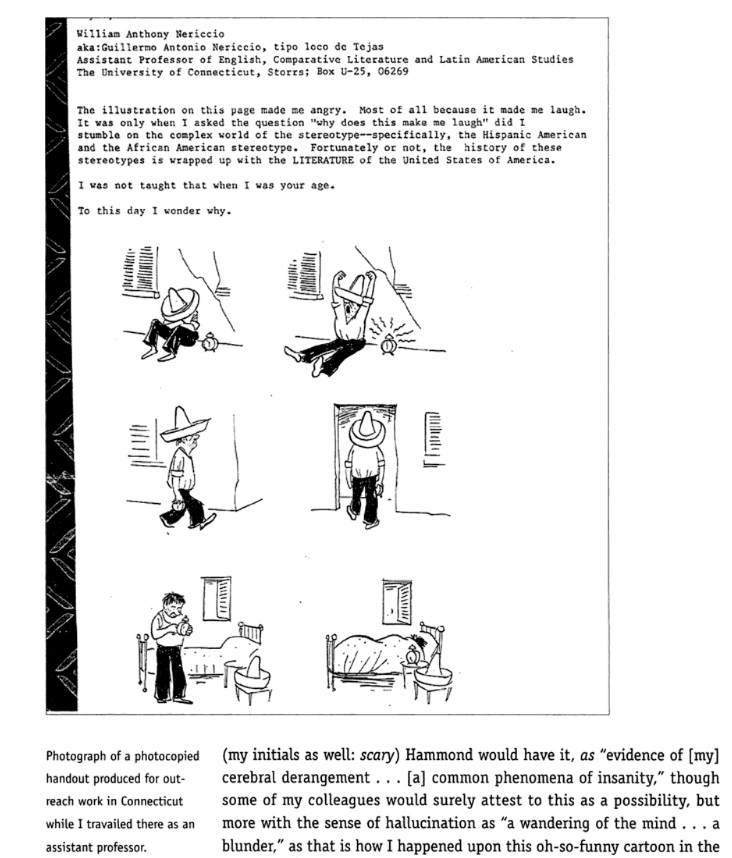
|
|
TUESDAY
OCTOBER 25
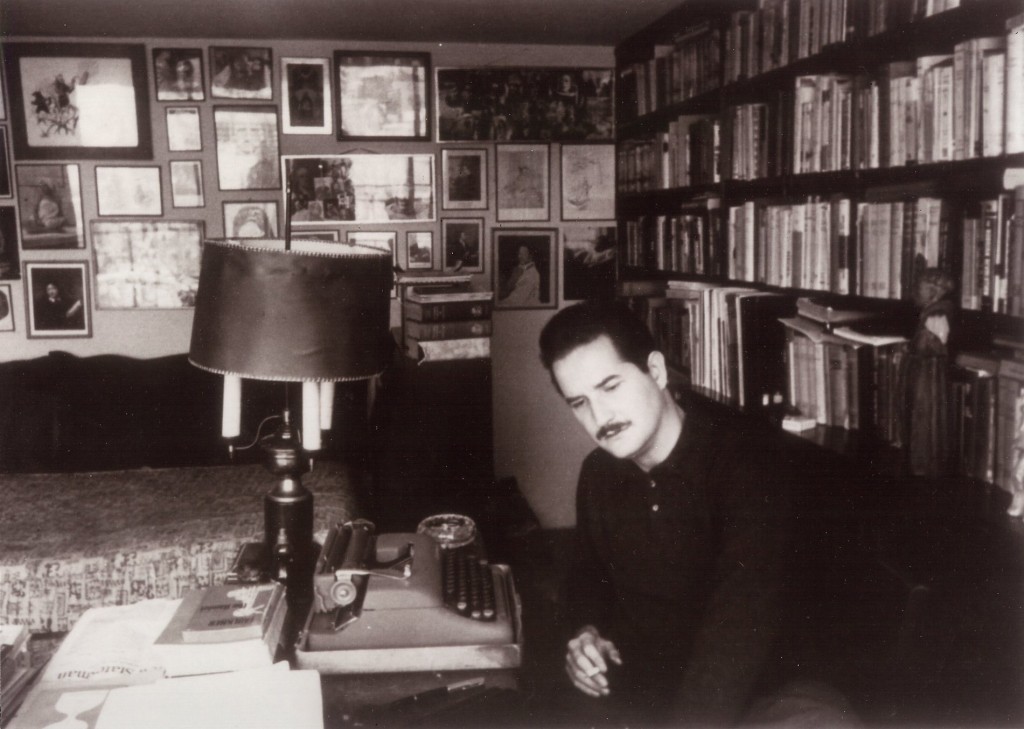
It is a
special day today as the film production team and crew
of Mextasy enter our palace
of psychotropic pedagogical fun to film a segment of
their TV show now in development--should you dress up? That's
up to you, but it's always good to be ready for your
closeup, no? Sorry, filming cancelled.
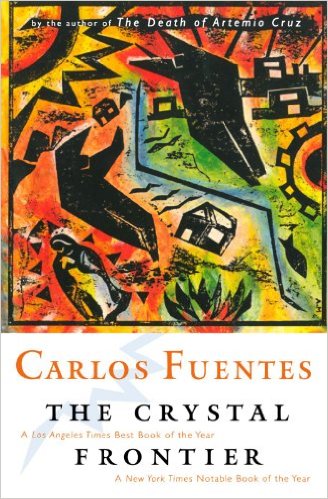 For class, do your best to read all
of Carlos Fuentes's THE CRYSTAL FRONTIER--if you have to
concentrate on specific chapters, you might want to
focus on Pain, The
Line of Oblivion, Malinztin of the Maquilas, The
Crystal Frontier, and Rio Grande Rio Bravo.
Fuentes's evocative novel attempts to refigure the very
lands under our feet, revision the contours of a
contentious, rich land where the legacies and destinies
of Europe and the Americas find their crossroads. This
class, too, is special for me as Fuentes was my mentor
at Cornell at a crisis moment of my academic career. In
a little way, this lecture is an attempt to say gracias
to a writer, a teacher, and a friend, who changed my
life forever. For class, do your best to read all
of Carlos Fuentes's THE CRYSTAL FRONTIER--if you have to
concentrate on specific chapters, you might want to
focus on Pain, The
Line of Oblivion, Malinztin of the Maquilas, The
Crystal Frontier, and Rio Grande Rio Bravo.
Fuentes's evocative novel attempts to refigure the very
lands under our feet, revision the contours of a
contentious, rich land where the legacies and destinies
of Europe and the Americas find their crossroads. This
class, too, is special for me as Fuentes was my mentor
at Cornell at a crisis moment of my academic career. In
a little way, this lecture is an attempt to say gracias
to a writer, a teacher, and a friend, who changed my
life forever.
|
|
THURSDAY
OCTOBER 27
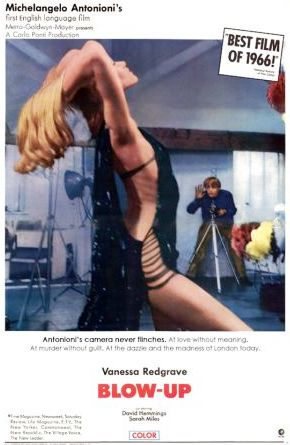 Today, in
class, we will begin screening Michelangelo
Antonioni's perplexing BLOW-UP. With TOUCH OF EVIL, we
were trapped in the psychologically chaotic world
between two borders, but we are no safer in
Antonioni's London. Here, too, we feel submerged
into a world of paranoia and surveillance.
Meaning itself starts to dissolve into undecidability. Today, in
class, we will begin screening Michelangelo
Antonioni's perplexing BLOW-UP. With TOUCH OF EVIL, we
were trapped in the psychologically chaotic world
between two borders, but we are no safer in
Antonioni's London. Here, too, we feel submerged
into a world of paranoia and surveillance.
Meaning itself starts to dissolve into undecidability.
 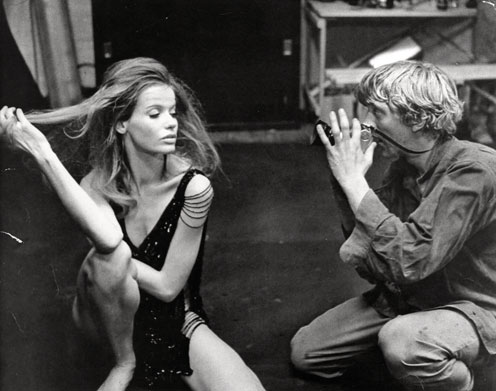
Here's a period trailer for the movie:
|
|
TUESDAY
NOVEMBER 1
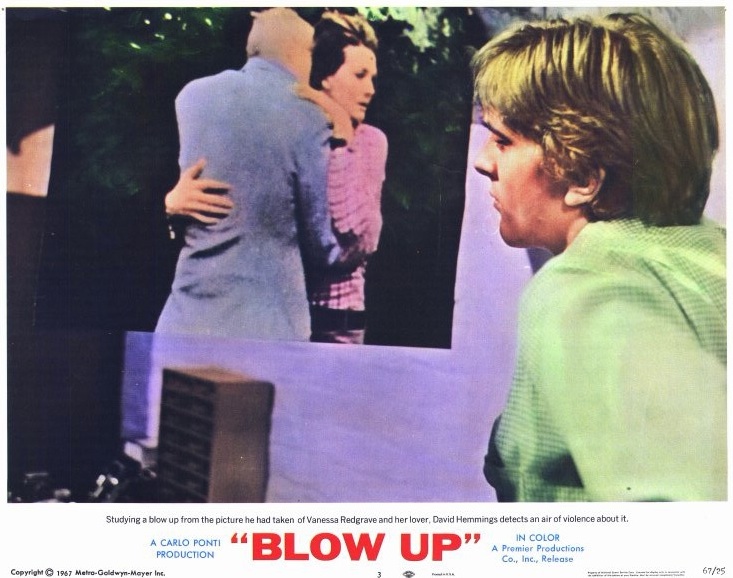
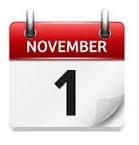 Can you believe it? It is the 9nth week of
the semester already--and we are on the home stretch
with the bulk of our reading for the semester
completed (for most of you ;-0 in any case). So
several things loom on the horizon--your 2nd major
imagination challenge, see below; your final exam,
click for sample finals from the past that I have
given here;
and one more cool novel, see November 8, 2016 below. Can you believe it? It is the 9nth week of
the semester already--and we are on the home stretch
with the bulk of our reading for the semester
completed (for most of you ;-0 in any case). So
several things loom on the horizon--your 2nd major
imagination challenge, see below; your final exam,
click for sample finals from the past that I have
given here;
and one more cool novel, see November 8, 2016 below.
This will be a good part of the semester to catch up
on any reading you may have missed (or skipped) as it
is bound to catch up with you on the final
if you have done so.  This moment of the semester also presents
you with added time to review--ample time to be sure
you know the
names of authors, major characters from the books
and cinema we have surveyed, and the meanings of
the various and sundry psychedelic TOOLGIZMOS™ (Literary/Cinematic toolkit words like La
Quiebra, Allusion, Epigraph, etc) we have introduced
throughout the semester. This moment of the semester also presents
you with added time to review--ample time to be sure
you know the
names of authors, major characters from the books
and cinema we have surveyed, and the meanings of
the various and sundry psychedelic TOOLGIZMOS™ (Literary/Cinematic toolkit words like La
Quiebra, Allusion, Epigraph, etc) we have introduced
throughout the semester.
What will we do today in GMCS 333? We will complete our
screening of Antonioni's BLOW-UP. In class we
continue our discussion of the film's meditation on
film, photography, surveillance, posing, and cinema.
Plus, of course, as this is a fusion week with Professor
Smigel's class, we have joint readings: it's
Psychedelic Supergroups/British Bad Boys week! Between
Thomas, the photographer in Blow-Up with his
phallus-proxing camera and Mick "Is that your microphone
or are you just glad to see me microphone" Jagger, we
may not get out of this week on one piece!
Listening: The
Yardbirds, “Happenings Ten Years Time Ago” (1966)
Cream,
“Sunshine of Your Love” (1967) Traffic,
“Paper Sun” (1967)
Reading: Jann
Wenner, “The Rolling Stone Interview: Eric Clapton”
(1968)
|
Imagination Challenge
Numero 2 is now LIVE
TODAY, Tuesday November 1, 2016 !!!! Click here
or hit the guy blown away below with your cursor.
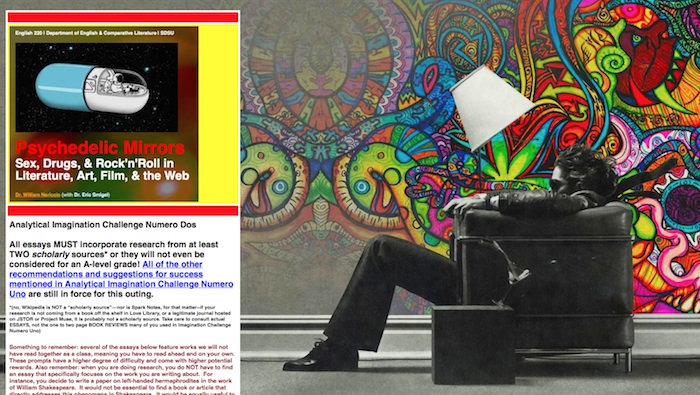
|
|
THURSDAY
NOVEMBER 3
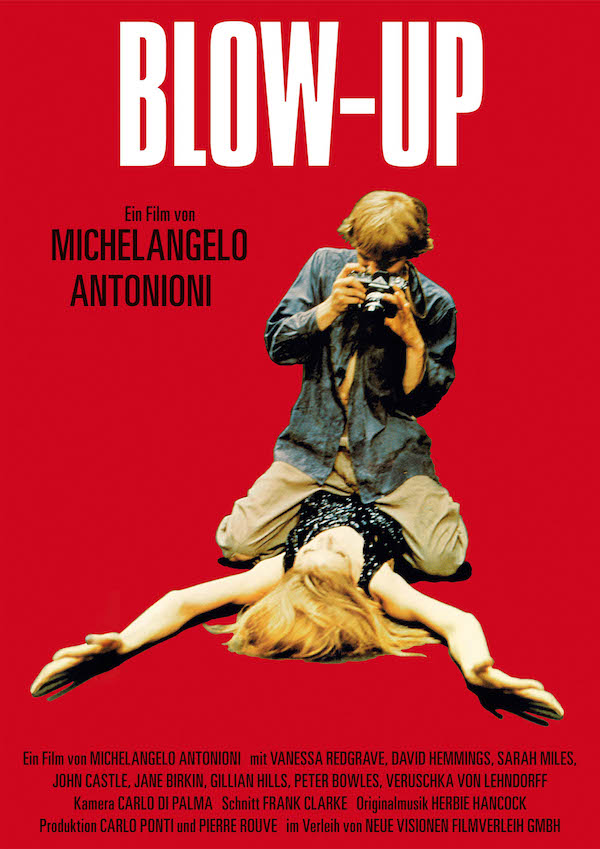  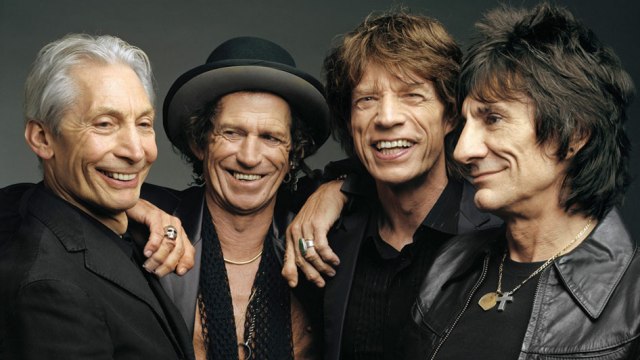
It's BRITISH BAD BOYS day for Professor
Nericcio and Smigel's classes--that's right! a joint
meeting of the two psychedelic mobs in the Don
Powell Theatre. CLASS WILL MEET IN THE DON POWELL
THEATRE
PREPARATION:
Listening: Rolling
Stones, “She’s a Rainbow” (1967) The
Who, “I Can See for Miles” (1967)
Reading: Jann
Wenner, “Rolling Stone Interview: Pete Townshend”
(1968)
|
|
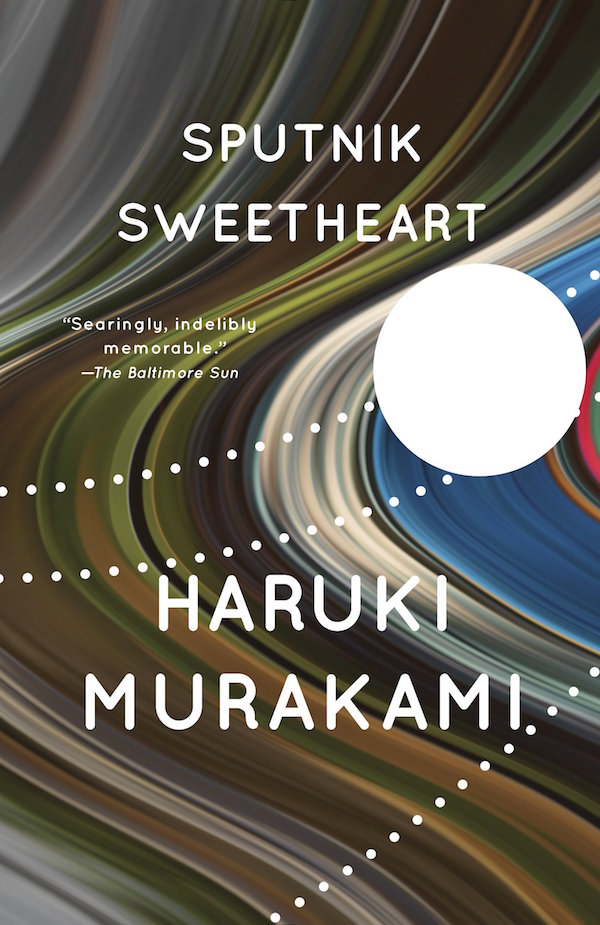 TUESDAY
NOVEMBER 8 TUESDAY
NOVEMBER 8
Read to at least page 122 in Haruki Murakami's SPUTNIK
SWEETHEART. By this time of the semester you have been
exposed to a diverse collection of texts--many innovative
and iconoclastic: works that bend and reshape the
conventions of storytelling. Come to class ready to
discuss what Murakami adds to the mix--how his experiments
in storytelling push the evolution of the Novel.
|
|
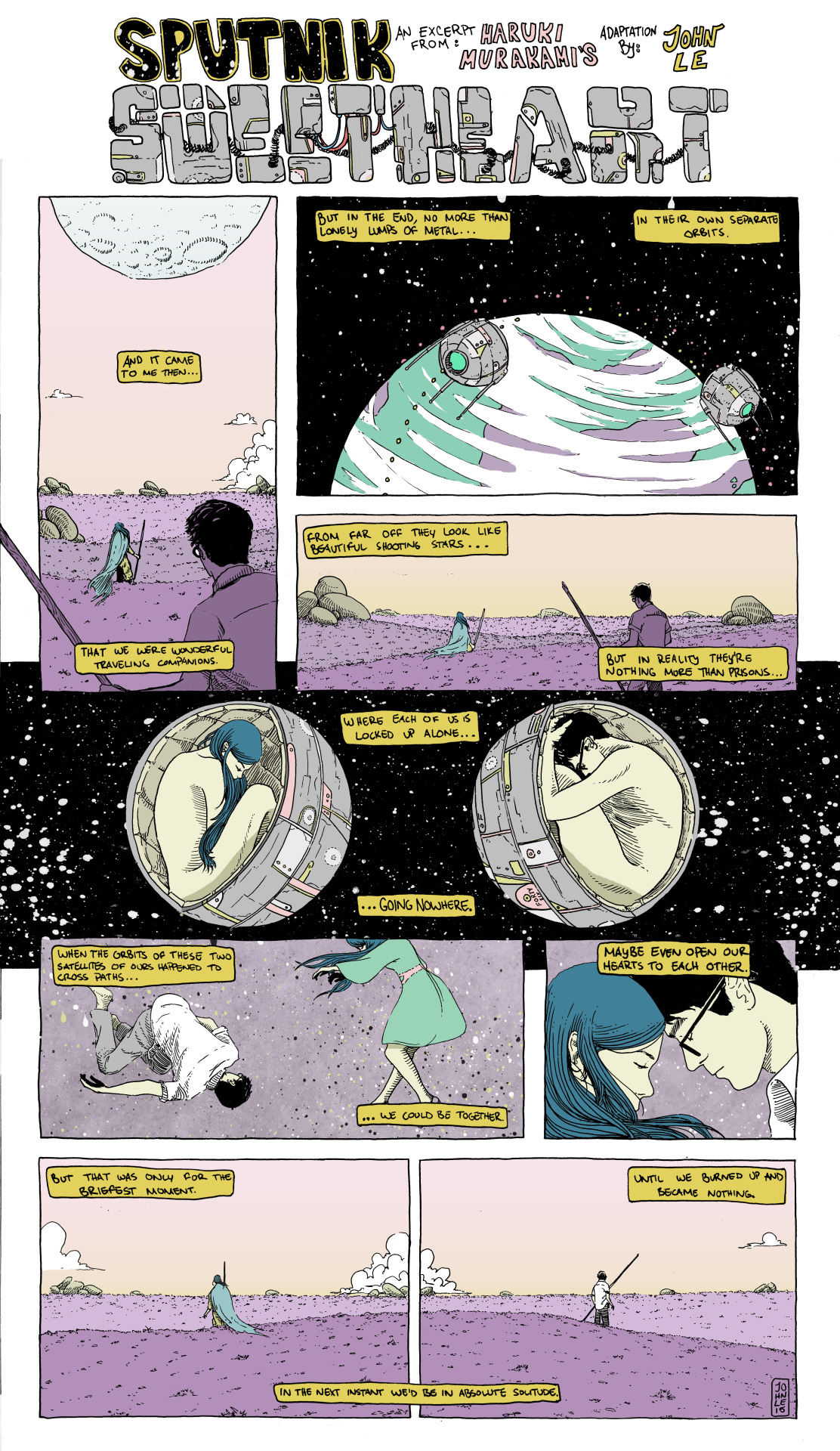
|
THURSDAY NOVEMBER 10
Complete your reading of Murakami's
novel--come to class with a sheet of paper.
What's on this sheet of paper? 1. Fold it in
half towards yourself and write your name as big
as you can on the outside along with your group
name (drawings also welcome). 2. On the inside,
print your name again and list the name of your
group
as well. 3. Write out (print if your writing is
not legible) what you view to be the two or
three key/pivotal/amazing lines you run across
in Murakami's novel. Come to class with
this sheet of paper.
Check out the adaptation, opposite--an evocative
rendition!
|
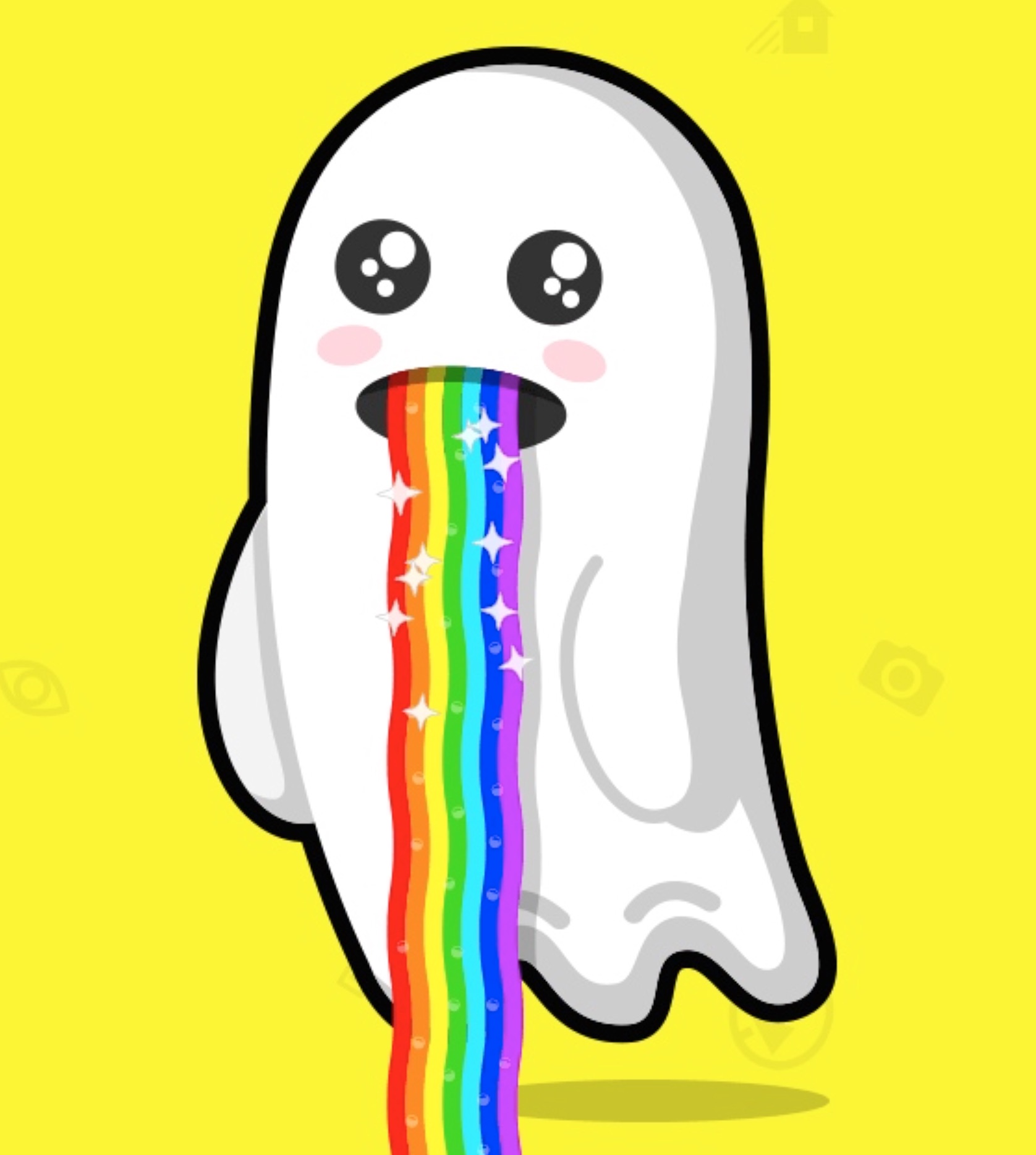 
NOTE: REMEMBER your
snapchat posting is due by 10am, Friday November 11,
2016
|
|
TUESDAY
NOVEMBER 15
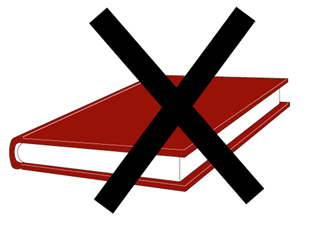 You are in
writing mode what with Imagination Challenge Numero Dos on
the horizon for Thursday, so this week: NO READING!* You are in
writing mode what with Imagination Challenge Numero Dos on
the horizon for Thursday, so this week: NO READING!*
*Except for all of the wonderful reading you are doing
whilst researching your masterwork essay for us. And
except for all the reading and re-reading you will do of
your essay before you turn it in because if you turn it in
without proofreading and without a concern for spelling,
grammar, and the basic rules of the English languague, we
may not read past the first page!
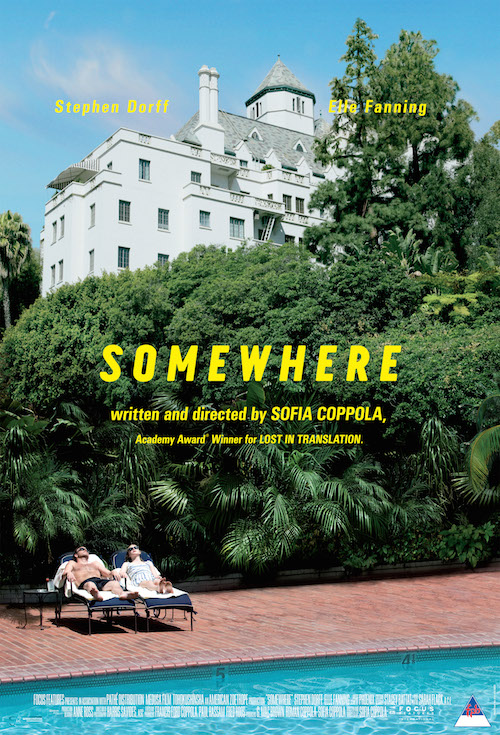 In class, we will begin our
screening and discussion of Sofia Coppola's SOMEWHERE, her
masterwork filmed treatment focused on the life (and the
consequences of that life) in Hollywood. If there is
any medium that can warp the human psyche's balance,
destroy the equilibrium of human consciousness, it is
Hollywood--and Coppola's funny/sad motion picture, focused
on the day to day life of Johnny Marco (played by Stephen
Dorff, self-exiled in the curious corridors of LA's
Chateau Marmont), is one of the best self-examinations of
Hollywood (by a Hollywood native, Sophia Coppola, the
daughter of Academy Award-winning director, Francis Ford
Coppola) since Billy Wilder's SUNSET BOULEVARD. In class, we will begin our
screening and discussion of Sofia Coppola's SOMEWHERE, her
masterwork filmed treatment focused on the life (and the
consequences of that life) in Hollywood. If there is
any medium that can warp the human psyche's balance,
destroy the equilibrium of human consciousness, it is
Hollywood--and Coppola's funny/sad motion picture, focused
on the day to day life of Johnny Marco (played by Stephen
Dorff, self-exiled in the curious corridors of LA's
Chateau Marmont), is one of the best self-examinations of
Hollywood (by a Hollywood native, Sophia Coppola, the
daughter of Academy Award-winning director, Francis Ford
Coppola) since Billy Wilder's SUNSET BOULEVARD.
|
|
THURSDAY
NOVEMBER 17
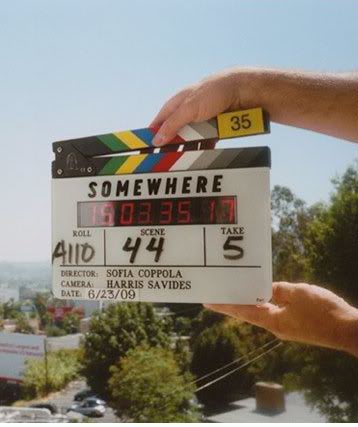
Today we finish our screening/discussion of Sofia
Coppola's SOMEWHERE...and we walk into our psychedelic den
of troublemaking, GMCS 333 with a gift in our hands!
That's right:
Analytical Imagination Challenge Numero Dos (2) is
Due Today at the Beginning of Class!
Drop your finished essay into the receptacle that
corresponds to your amazing TA or LIVE DANGEROUSLY and
drop into Professor Nericcio's delirious bag of tricks!
|
|
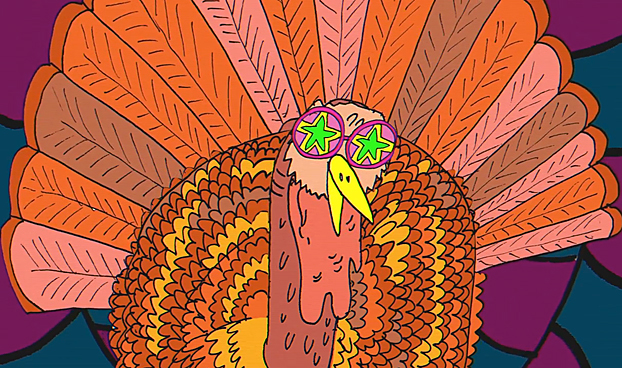 TUESDAY NOVEMBER 22 TUESDAY NOVEMBER 22
THANKSGIVING
NO CLASS--enjoy the break with your friends and
familia.
|
|
 THURSDAY
NOVEMBER 24 THURSDAY
NOVEMBER 24
THANKSGIVING
NO CLASS--why are you even looking here!????
Go eat too much and have a great holiday!
|
|
TUESDAY
NOVEMBER 29
 NO CLASS TODAY IN
GMCS 333!!!! NO CLASS TODAY IN
GMCS 333!!!!
Why!!!!????? Instead, you will have made plans to
attend for free the performance of JESUS CHRIST
SUPERSTAR tomorrow,
WEDNESDAY, Nov. 30!
Show
up to the Don Powell theatre at 6:45pm so that you
can have time to find a seat for the pre-show chat
with Professors Smigel & Nericcio, along with a
couple of other experts from the School of Theatre,
Television, and Film--you must go up to the box
office to be admitted. The show begins right after
this introduction.
We have cancelled class so that you can be there with
us and this date has been on the calendar since
September. If, however, you cannot make this
performance, you are welcome to attend the four other
performances December 1, 2, 3, or 4, but you will have
to pay the $15 fee and hold onto your ticket to prove
you indeed attended. Details.
|
|
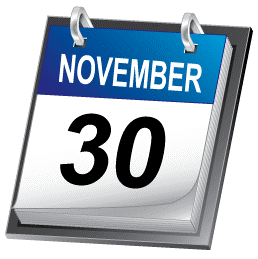 WEDNESDAY NOVEMBER
30: WEDNESDAY NOVEMBER
30:
Special NIGHT
class as we all go to the Don Powell for a groovy
night of JESUS CHRIST SUPERSTAR. Admission is
free--details to follow!
|
 THURSDAY
DECEMBER 1 THURSDAY
DECEMBER 1
Jesus Christ Superstar discussion session! The
bulk of the class will be spent in a focused
discussion/review of our experience in the Don Powell
Theatre the night before.
|
|
TUESDAY
DECEMBER 6
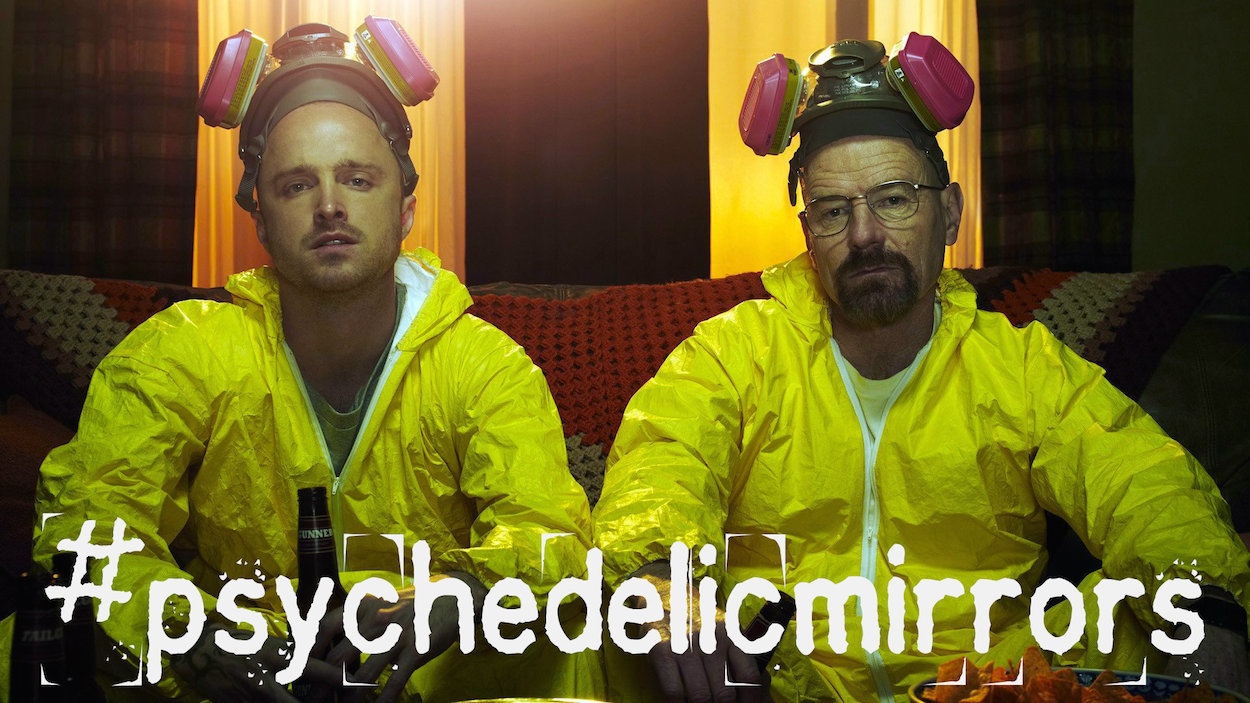
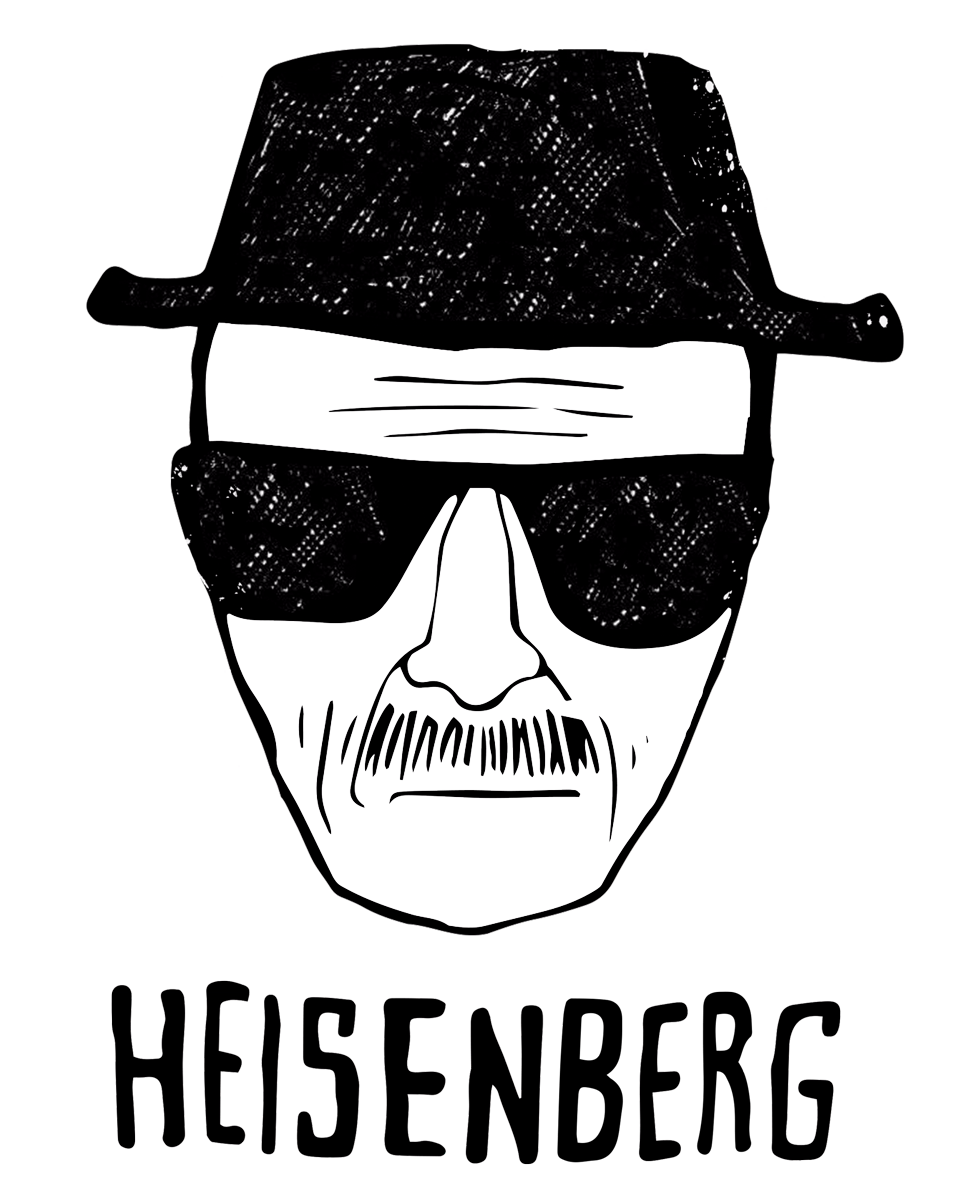 In
this,
our final regular class, we will here a commercial from my
great colleague Andy Wiese, Chair, History, on his London
Summer 2017 program; next we will review for the Final
Exam, aka the Final In-Class Imagination Challenge; and
last, but not least, we will experience our last required
text of the semester together, the "Phoenix" episode
of BREAKING BAD, Directed by Colin Bucksey, with a
screenplay by the series creator Vince Gilligan, with John
Shiban--"Phoenix" was the 12th episode of season 2 for
those keeping track of these things. By the early part of
the 21st century we have moved out of an era where drugs
were imagined as a form of escape or a vehicle for
self-introspection. The world of BREAKING BAD is a blue
crytal-meth world of pain, angst, addiction, selfishness,
and greed--with a main character split between the once
mild-mannered Walter White and the scary kingpin
Heisenberg. In
this,
our final regular class, we will here a commercial from my
great colleague Andy Wiese, Chair, History, on his London
Summer 2017 program; next we will review for the Final
Exam, aka the Final In-Class Imagination Challenge; and
last, but not least, we will experience our last required
text of the semester together, the "Phoenix" episode
of BREAKING BAD, Directed by Colin Bucksey, with a
screenplay by the series creator Vince Gilligan, with John
Shiban--"Phoenix" was the 12th episode of season 2 for
those keeping track of these things. By the early part of
the 21st century we have moved out of an era where drugs
were imagined as a form of escape or a vehicle for
self-introspection. The world of BREAKING BAD is a blue
crytal-meth world of pain, angst, addiction, selfishness,
and greed--with a main character split between the once
mild-mannered Walter White and the scary kingpin
Heisenberg.
 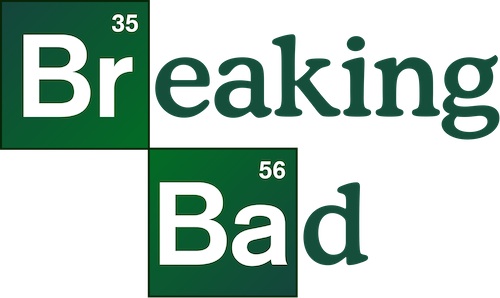
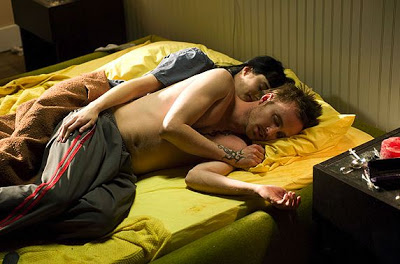 |
|
THURSDAY DECEMBER 8
Acid Test Instructions for today now LIVE!
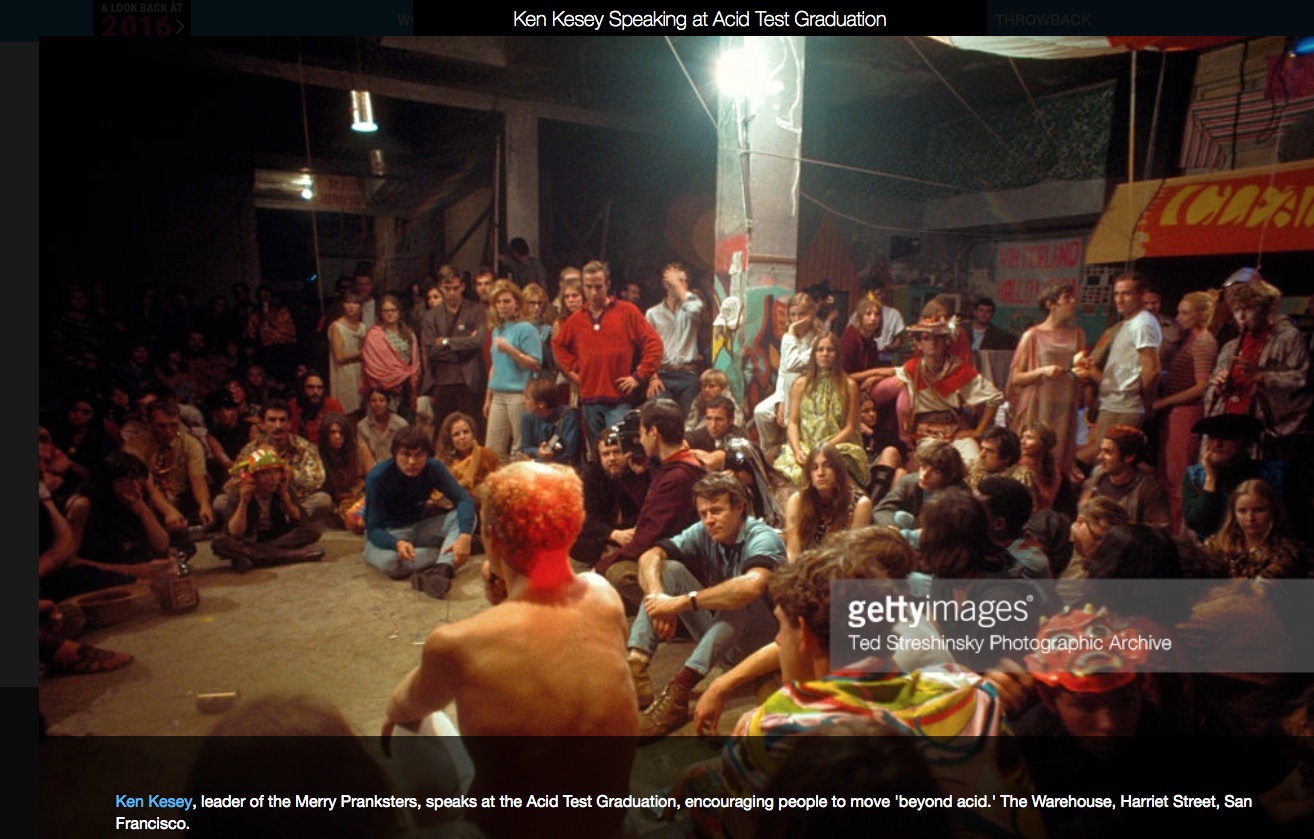
 December 8: Psychedelic
Mirrors Acid Test; Joint meeting #4! Today
is the day for our rock concert, scene, event,
happening!
CLASS WILL MEET IN MONTEZUMA HALL AT 11:00am
sharp--try to get there a little early if you can,
by 10:55am!!!!!! December 8: Psychedelic
Mirrors Acid Test; Joint meeting #4! Today
is the day for our rock concert, scene, event,
happening!
CLASS WILL MEET IN MONTEZUMA HALL AT 11:00am
sharp--try to get there a little early if you can,
by 10:55am!!!!!!
|
|
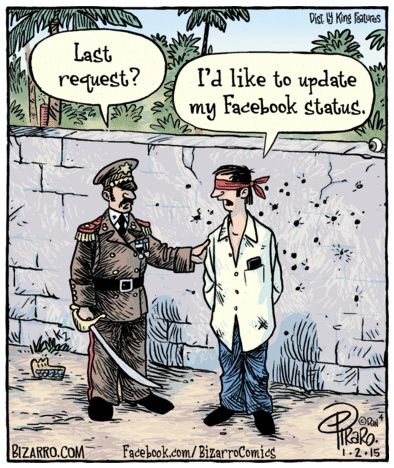 TUESDAY DECEMBER 13 TUESDAY DECEMBER 13
FINAL EXAM in GMCS 333 @ 11am sharp! Here are
some sample finals so you don't come into the
trippy experience utterly blind (nor surprised)--your
final will follow the exact same format at the
samples: the first part of the exam will consist of
fill-in-the-blank questions; the second part will
feature psychedelicTOOLGIZMOS™ and ask you to
adapt/apply them; the third part will be an essay.
|
|
 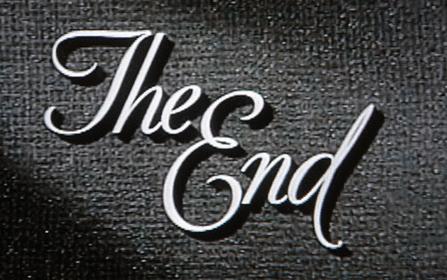 |
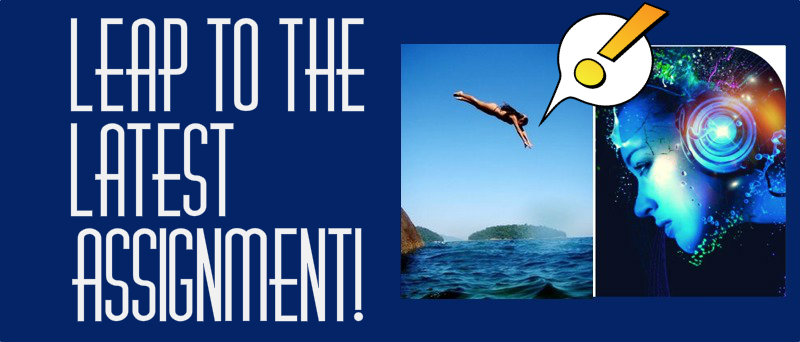



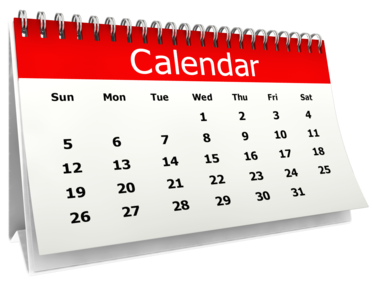




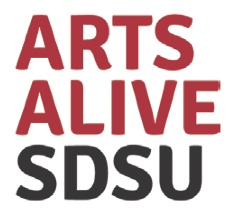




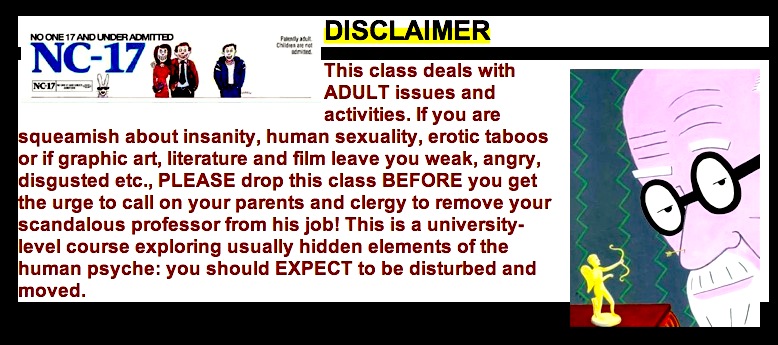


 t's
a
fine Tuesday morning, and you stumble into our
beautiful, utterly non-psychedelic auditorium (GMCS
333), having already read the first 63 pages or so of
SURREALISM by Cathrin Klingsöhr-Leroy. As you read,
bookmark the two works of art that MOST moved,
provoked, aroused OR confused you. Be prepared
with notes to share your findings with your
classmates. Your four psychedelicTOOLGIZMOS™ for
today are psyche,
hermeneutics,
overdetermination,
and allusion--follow
the links (that's why the words are blue!) if you
wish, but we will go over these terms IN CLASS.
t's
a
fine Tuesday morning, and you stumble into our
beautiful, utterly non-psychedelic auditorium (GMCS
333), having already read the first 63 pages or so of
SURREALISM by Cathrin Klingsöhr-Leroy. As you read,
bookmark the two works of art that MOST moved,
provoked, aroused OR confused you. Be prepared
with notes to share your findings with your
classmates. Your four psychedelicTOOLGIZMOS™ for
today are psyche,
hermeneutics,
overdetermination,
and allusion--follow
the links (that's why the words are blue!) if you
wish, but we will go over these terms IN CLASS.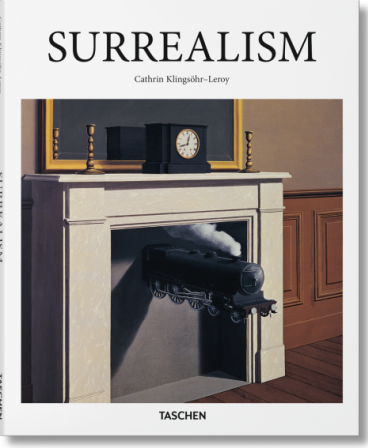
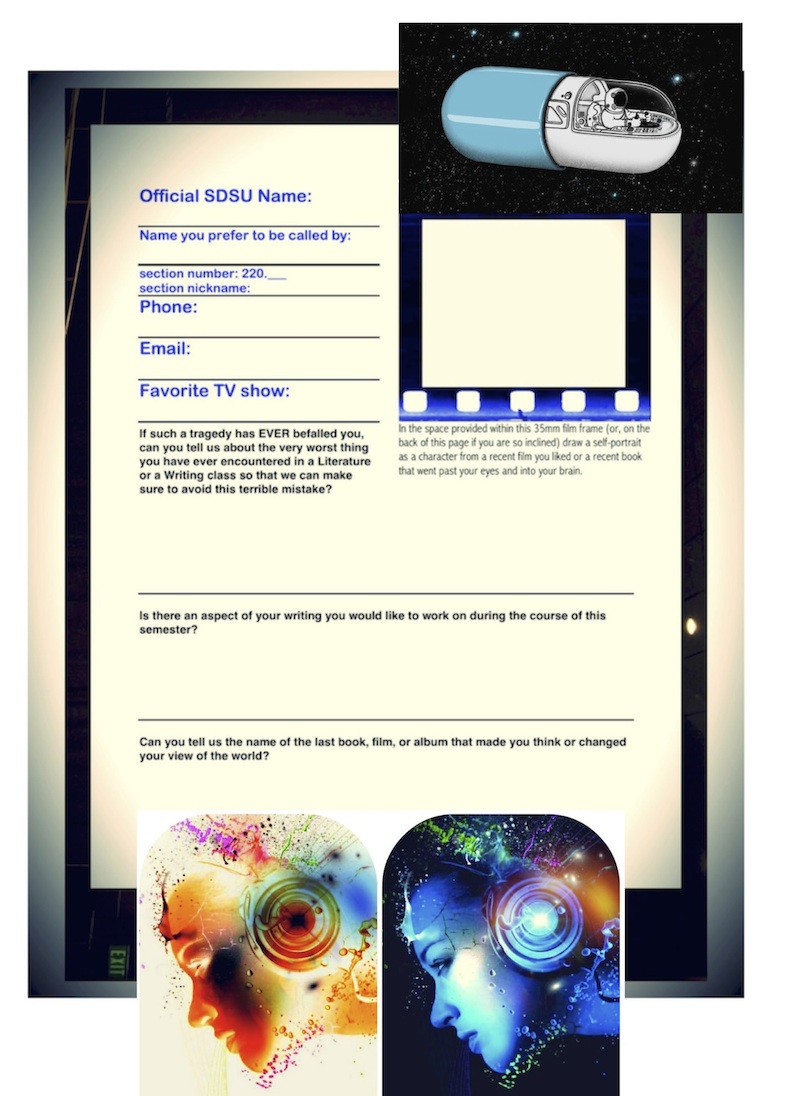

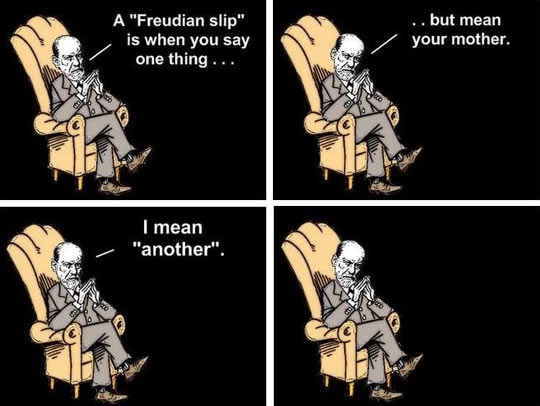
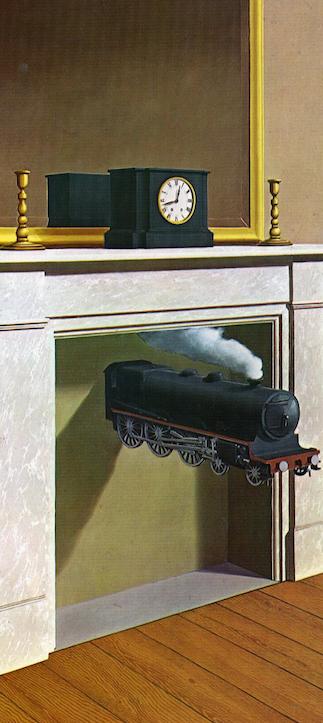

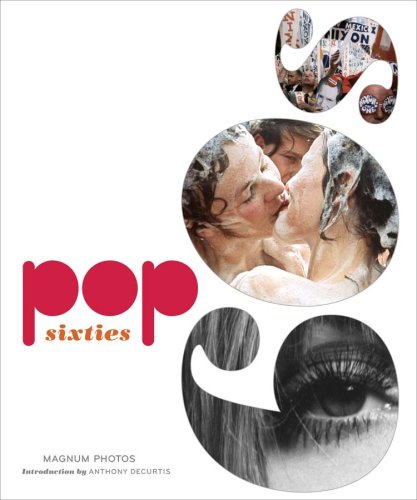
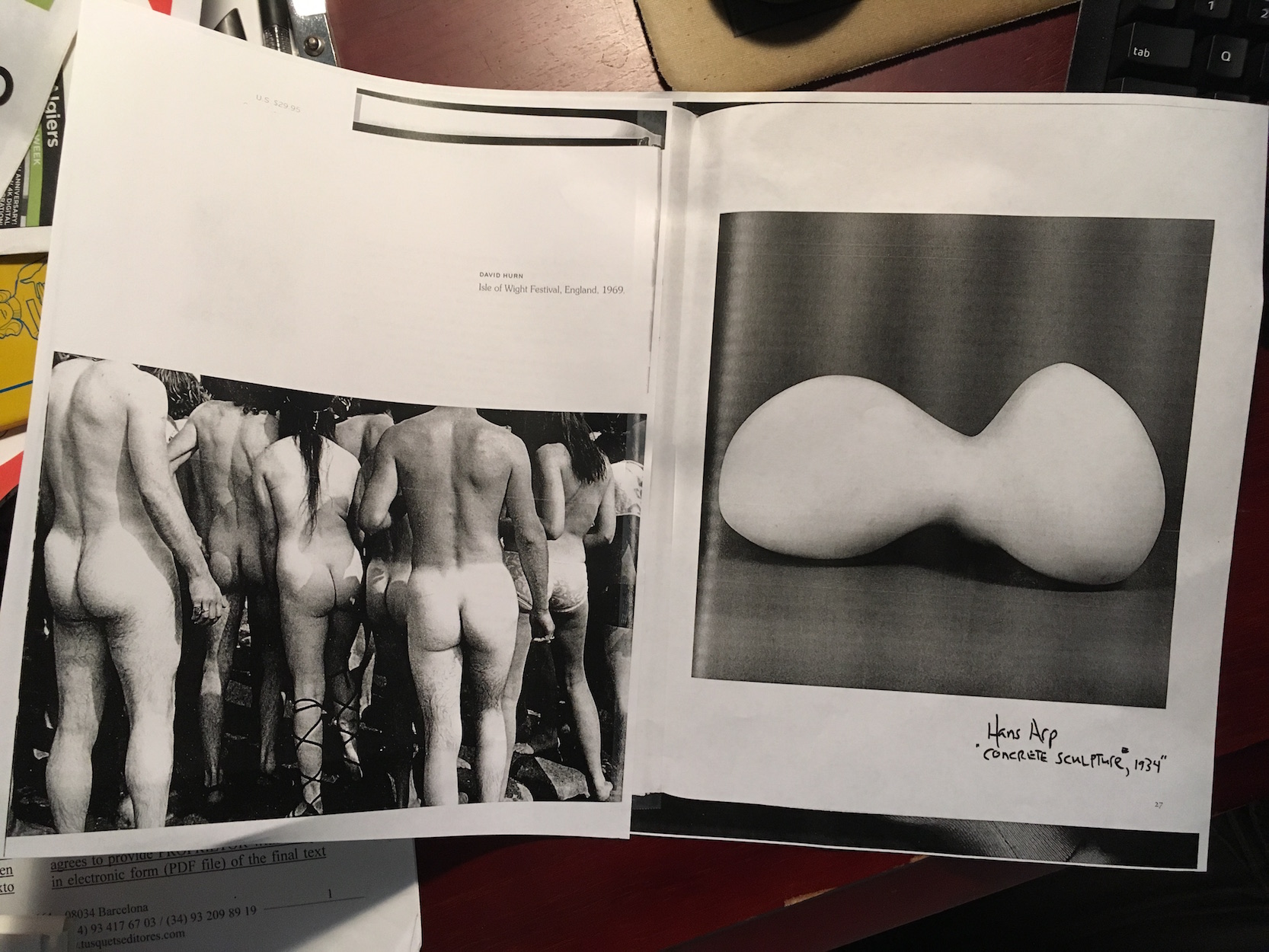
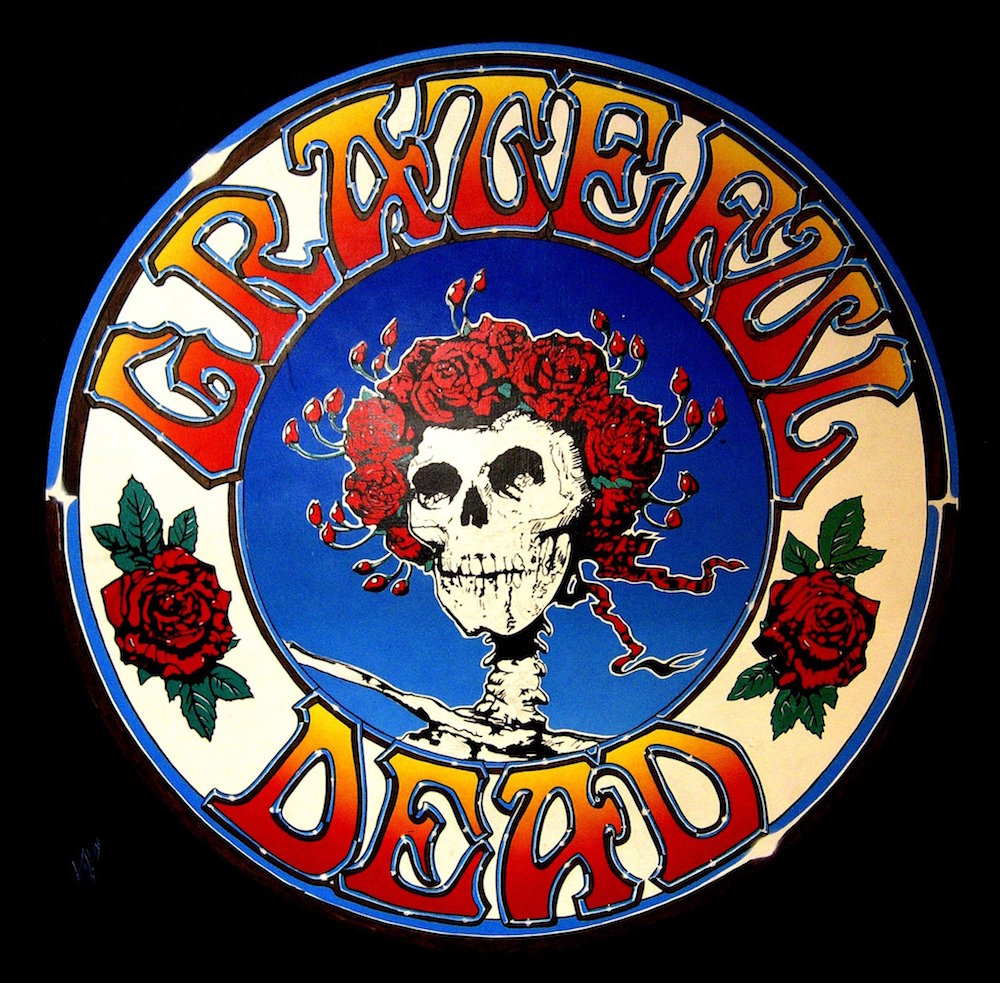
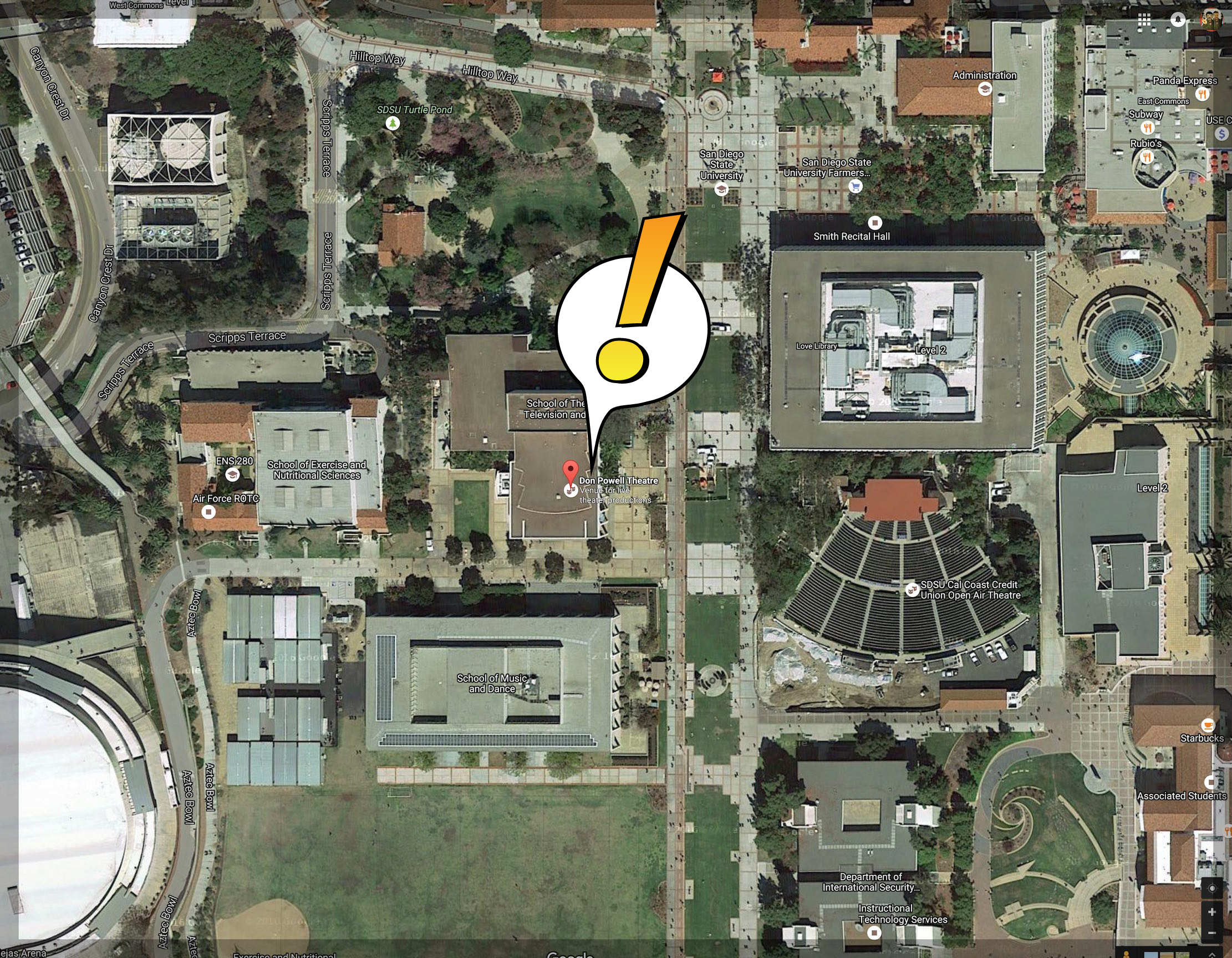
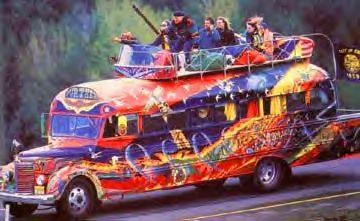



 Finally! Finally--the
silent literati in the room rejoice as we now, for the
first time plunge into some proper, real, bona fide,
LITERATURE--the short story masterpiece, "The Yellow
Wall-Paper" by Charlotte Perkins Gilman. The story
is short! Super-short. So the first time you read
the story, just sit down and read it straight through
without any stops.
Finally! Finally--the
silent literati in the room rejoice as we now, for the
first time plunge into some proper, real, bona fide,
LITERATURE--the short story masterpiece, "The Yellow
Wall-Paper" by Charlotte Perkins Gilman. The story
is short! Super-short. So the first time you read
the story, just sit down and read it straight through
without any stops. 
 This fine Tuesday is pretty
amazing. You walk into our den of psychedelic inquiry
having read up to the April 17nth chapter of Junichiro
Tanizaki's THE KEY. Unless you want to finish it as
most of you likely will do.
This fine Tuesday is pretty
amazing. You walk into our den of psychedelic inquiry
having read up to the April 17nth chapter of Junichiro
Tanizaki's THE KEY. Unless you want to finish it as
most of you likely will do.  At first glance, the
At first glance, the 

 Junichiro Tanizaki's
THE KEY is now in your rear-view window as you enter the
airy confines of GMCS 333. In preparation for today's
class, you have very little reading--the novel ends on
page 157 of the edition we ordered for your psychedelic
seminar. Instead, use the extra time you have when you
finish the book to go back and reread the first 20 or so
pages of the novel
Junichiro Tanizaki's
THE KEY is now in your rear-view window as you enter the
airy confines of GMCS 333. In preparation for today's
class, you have very little reading--the novel ends on
page 157 of the edition we ordered for your psychedelic
seminar. Instead, use the extra time you have when you
finish the book to go back and reread the first 20 or so
pages of the novel 


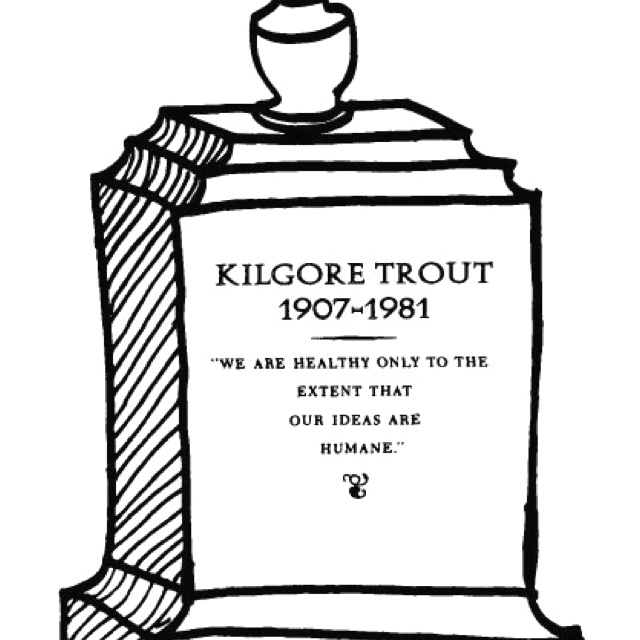

 20th century--and
certainly one of the more singular voices in the history
of literature. Know that Vonnegut's background was
NOT literary--he was a below average biochemistry
undergraduate at Cornell University (go Big Red!) and
later, a University of Chicago cultural anthropology
dropout. After surviving the Dresden firebombing in WWII,
he returned to the U.S. and worked as a spokesman for
General Electric. The time he spent in the bowels of
CORPORATE AMERICA did a number on his head (his psyche
too) and he spent the rest of his long, prolific life
sorting things out.
20th century--and
certainly one of the more singular voices in the history
of literature. Know that Vonnegut's background was
NOT literary--he was a below average biochemistry
undergraduate at Cornell University (go Big Red!) and
later, a University of Chicago cultural anthropology
dropout. After surviving the Dresden firebombing in WWII,
he returned to the U.S. and worked as a spokesman for
General Electric. The time he spent in the bowels of
CORPORATE AMERICA did a number on his head (his psyche
too) and he spent the rest of his long, prolific life
sorting things out. ALSO!
For
the second time this semester, we are synchronizing our
psyches with the 200 students in Professor Eric Smigel's
class--so do take the time to peruse the links to that
material!
ALSO!
For
the second time this semester, we are synchronizing our
psyches with the 200 students in Professor Eric Smigel's
class--so do take the time to peruse the links to that
material!


 Music and the
Psyche--Nick Hornby's HIGH FIDELITY
Music and the
Psyche--Nick Hornby's HIGH FIDELITY
 Try as hard as you can to finish
reading Nick Hornby's HIGH FIDELITY!!!!!!
Try as hard as you can to finish
reading Nick Hornby's HIGH FIDELITY!!!!!!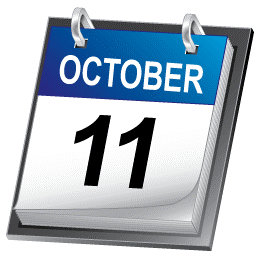




 Directed
by Scott Hornbacher with a screenplay by Semi Chellas and
series creator Matthew Weiner, the "Far Away Places,"
Season 5, Episode 6 (2012) chapter of AMC's
Directed
by Scott Hornbacher with a screenplay by Semi Chellas and
series creator Matthew Weiner, the "Far Away Places,"
Season 5, Episode 6 (2012) chapter of AMC's 
 For class today, read the Introduction to
Tex[t]-Mex entitled "
For class today, read the Introduction to
Tex[t]-Mex entitled "

 Our
screening of
Our
screening of 


 For class, do your best to read all
of Carlos Fuentes's THE CRYSTAL FRONTIER--if you have to
concentrate on specific chapters, you might want to
focus on
For class, do your best to read all
of Carlos Fuentes's THE CRYSTAL FRONTIER--if you have to
concentrate on specific chapters, you might want to
focus on  Today, in
class, we will begin screening Michelangelo
Antonioni's perplexing BLOW-UP. With TOUCH OF EVIL, we
were trapped in the psychologically chaotic world
between two borders, but we are no safer in
Antonioni's London. Here, too, we feel submerged
into a world of paranoia and surveillance.
Meaning itself starts to dissolve into undecidability.
Today, in
class, we will begin screening Michelangelo
Antonioni's perplexing BLOW-UP. With TOUCH OF EVIL, we
were trapped in the psychologically chaotic world
between two borders, but we are no safer in
Antonioni's London. Here, too, we feel submerged
into a world of paranoia and surveillance.
Meaning itself starts to dissolve into undecidability.



 Can you believe it? It is the 9nth week of
the semester already--and we are on the home stretch
with the bulk of our reading for the semester
completed (for most of you ;-0 in any case). So
several things loom on the horizon--your 2nd major
imagination challenge, see below; your final exam,
click for sample finals from the past that I have
given
Can you believe it? It is the 9nth week of
the semester already--and we are on the home stretch
with the bulk of our reading for the semester
completed (for most of you ;-0 in any case). So
several things loom on the horizon--your 2nd major
imagination challenge, see below; your final exam,
click for sample finals from the past that I have
given  This moment of the semester also presents
you with added time to review--ample time to be sure
you know
This moment of the semester also presents
you with added time to review--ample time to be sure
you know 



 TUESDAY
NOVEMBER 8
TUESDAY
NOVEMBER 8


 You are in
writing mode what with Imagination Challenge Numero Dos on
the horizon for Thursday, so this week: NO READING!*
You are in
writing mode what with Imagination Challenge Numero Dos on
the horizon for Thursday, so this week: NO READING!* In class, we will begin our
screening and discussion of Sofia Coppola's SOMEWHERE, her
masterwork filmed treatment focused on the life (and the
consequences of that life) in Hollywood. If there is
any medium that can warp the human psyche's balance,
destroy the equilibrium of human consciousness, it is
Hollywood--and Coppola's funny/sad motion picture, focused
on the day to day life of Johnny Marco (played by Stephen
Dorff, self-exiled in the curious corridors of LA's
Chateau Marmont), is one of the best self-examinations of
Hollywood (by a Hollywood native, Sophia Coppola, the
daughter of Academy Award-winning director, Francis Ford
Coppola) since Billy Wilder's SUNSET BOULEVARD.
In class, we will begin our
screening and discussion of Sofia Coppola's SOMEWHERE, her
masterwork filmed treatment focused on the life (and the
consequences of that life) in Hollywood. If there is
any medium that can warp the human psyche's balance,
destroy the equilibrium of human consciousness, it is
Hollywood--and Coppola's funny/sad motion picture, focused
on the day to day life of Johnny Marco (played by Stephen
Dorff, self-exiled in the curious corridors of LA's
Chateau Marmont), is one of the best self-examinations of
Hollywood (by a Hollywood native, Sophia Coppola, the
daughter of Academy Award-winning director, Francis Ford
Coppola) since Billy Wilder's SUNSET BOULEVARD.
 TUESDAY NOVEMBER 22
TUESDAY NOVEMBER 22 THURSDAY
NOVEMBER 24
THURSDAY
NOVEMBER 24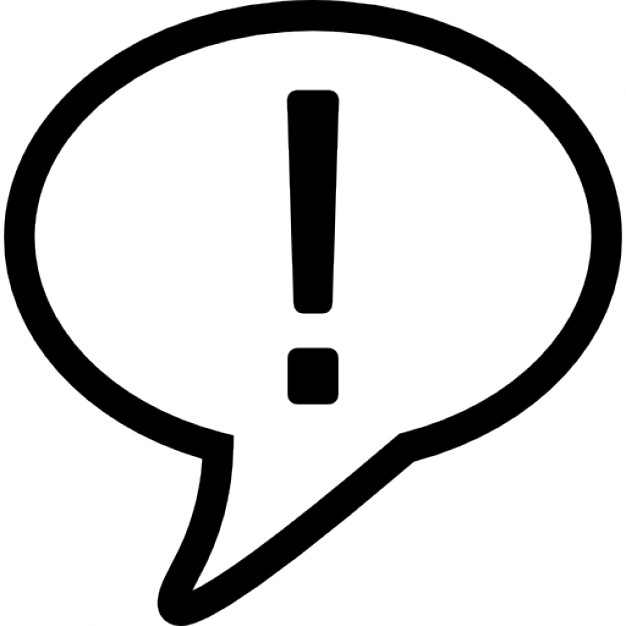
 NO CLASS TODAY IN
GMCS 333!!!!
NO CLASS TODAY IN
GMCS 333!!!! 
 THURSDAY
DECEMBER 1
THURSDAY
DECEMBER 1




 December 8: Psychedelic
Mirrors Acid Test; Joint meeting #4!
December 8: Psychedelic
Mirrors Acid Test; Joint meeting #4!  TUESDAY DECEMBER 13
TUESDAY DECEMBER 13

